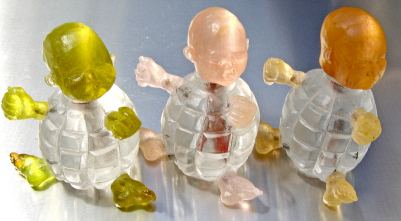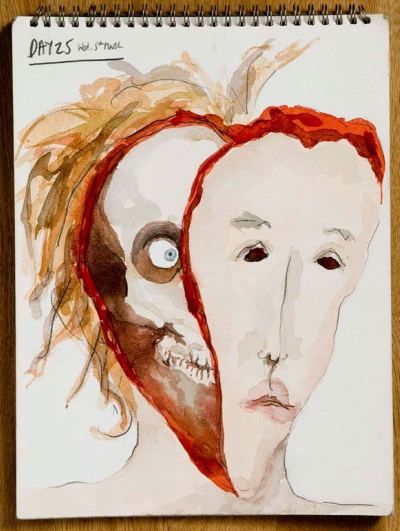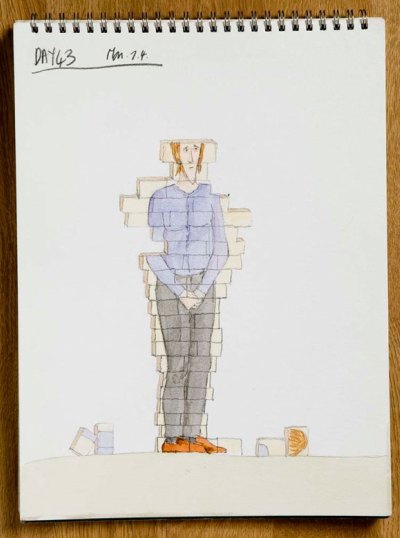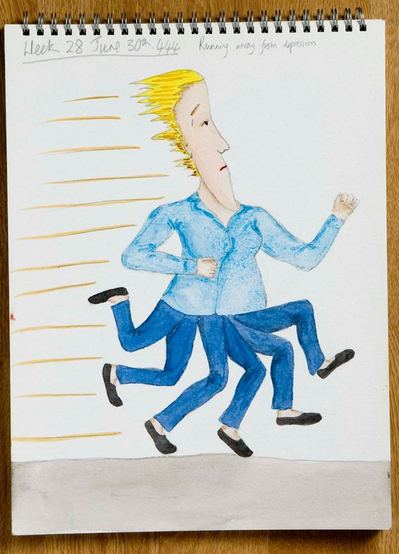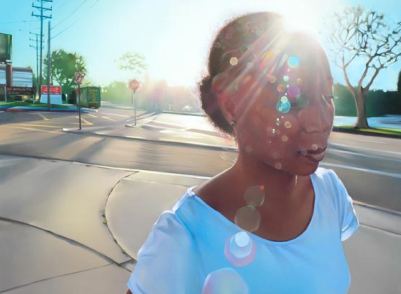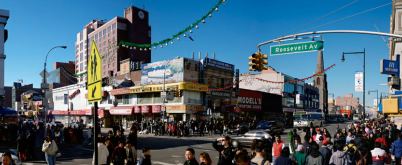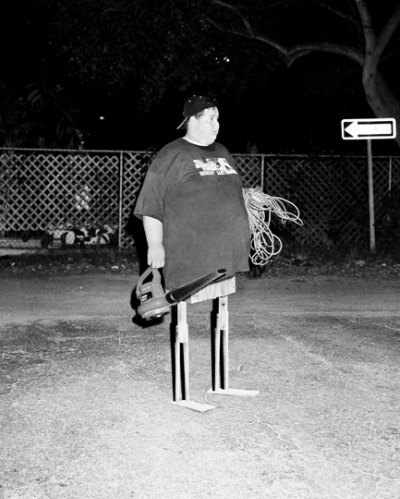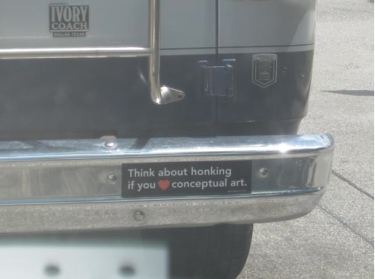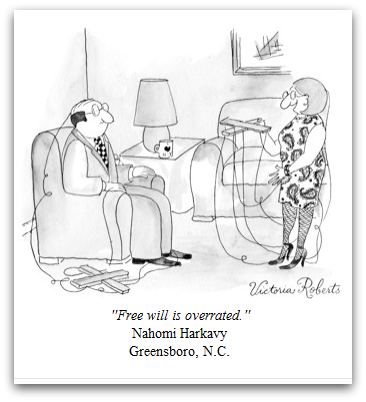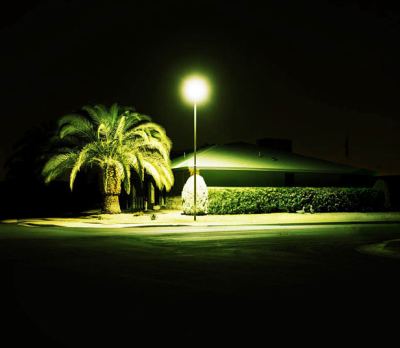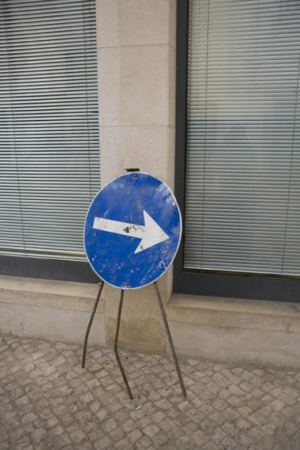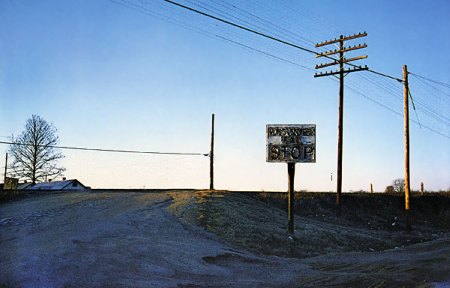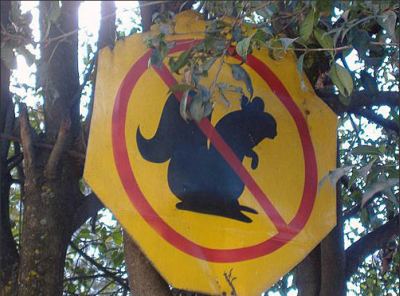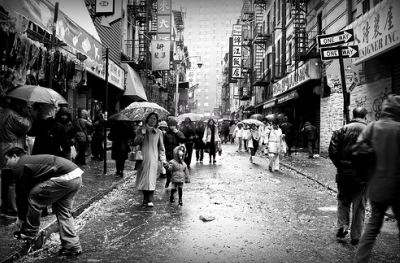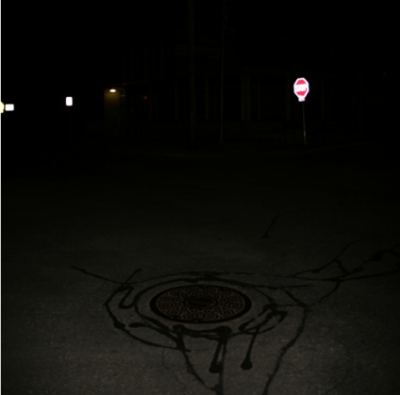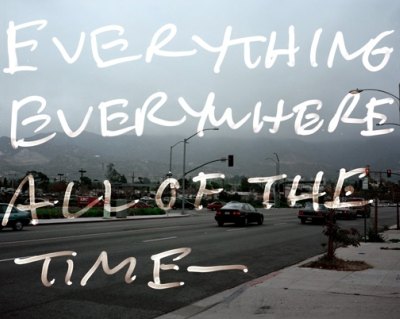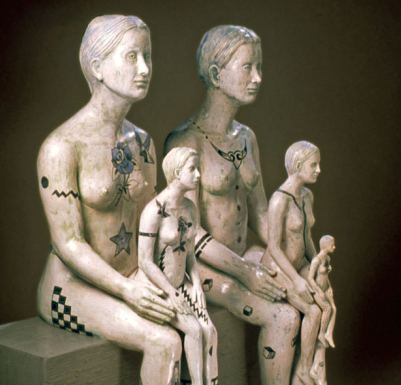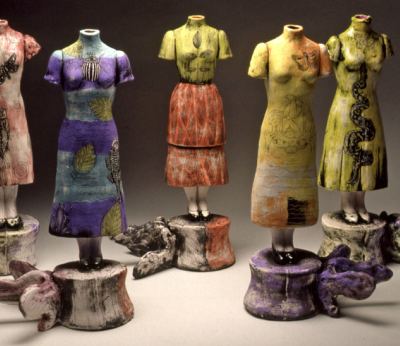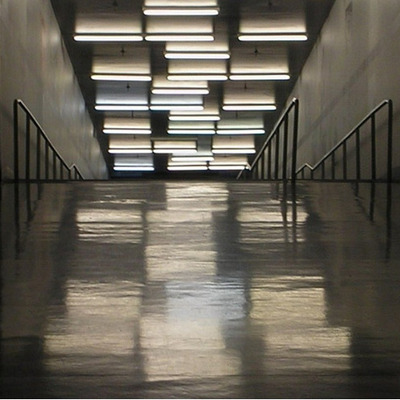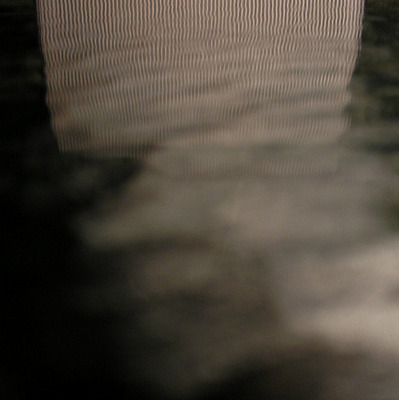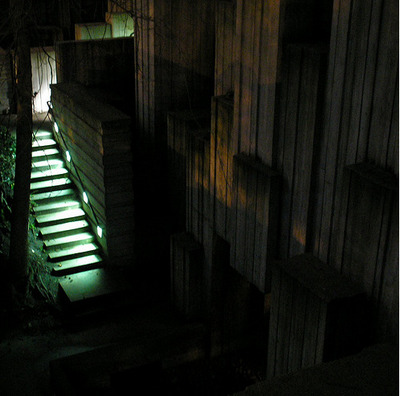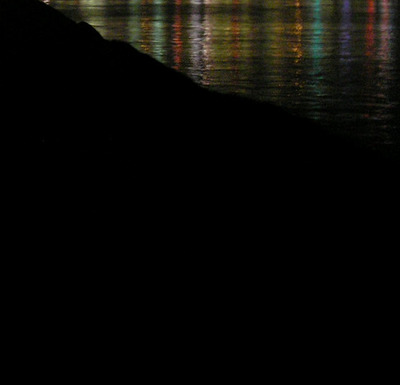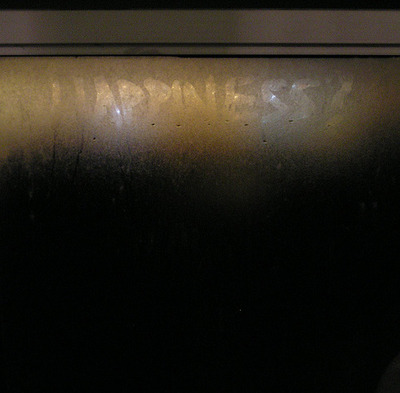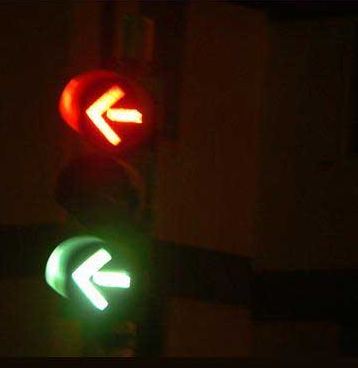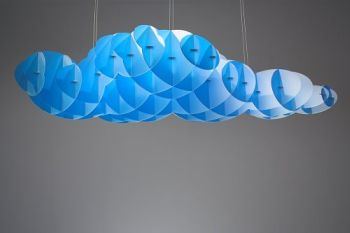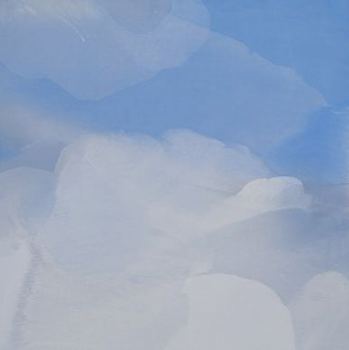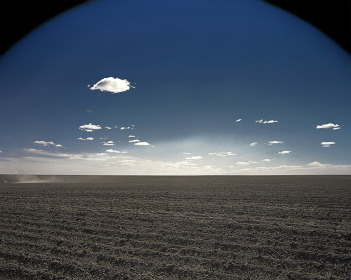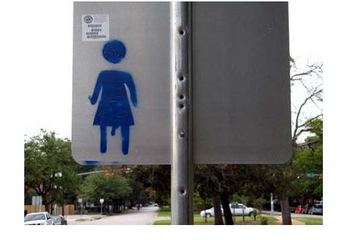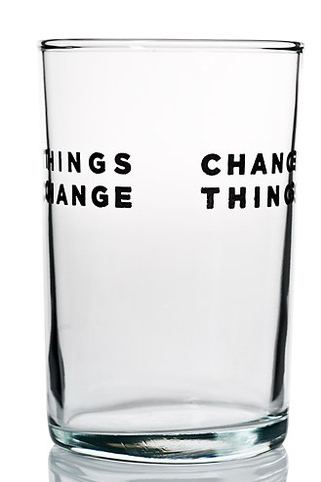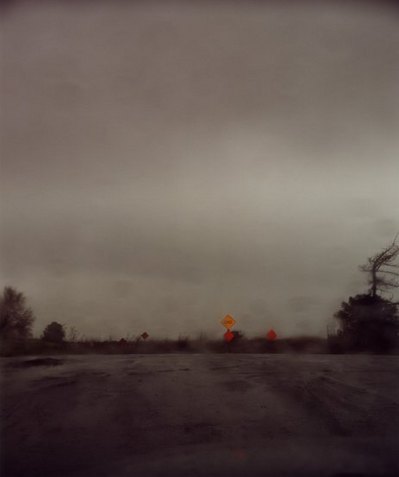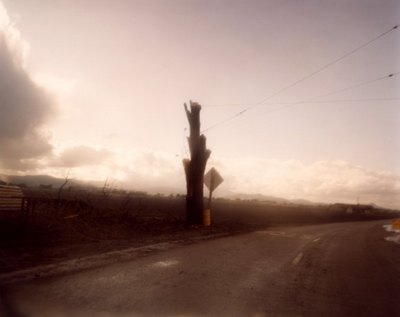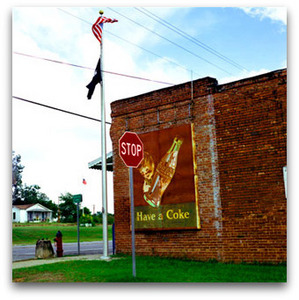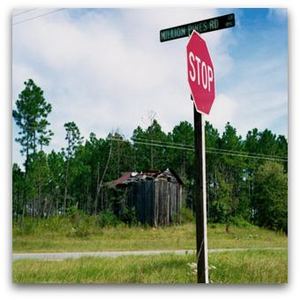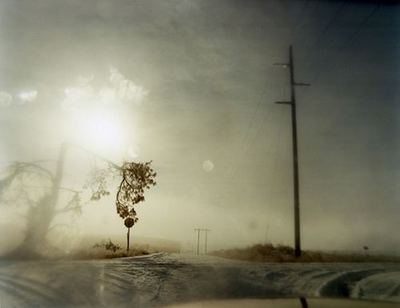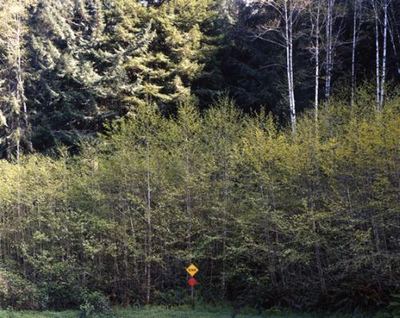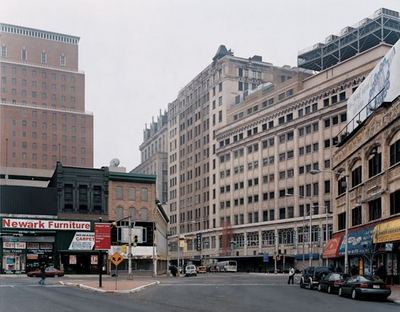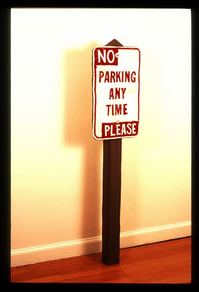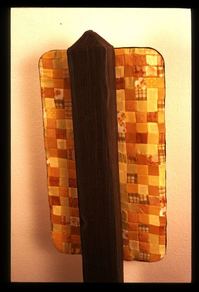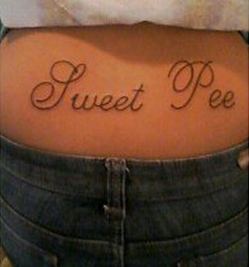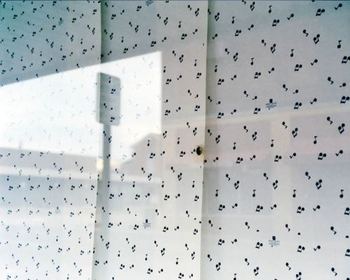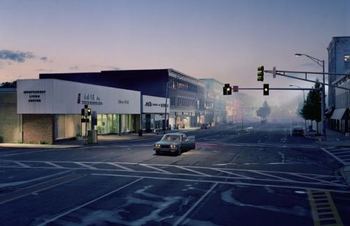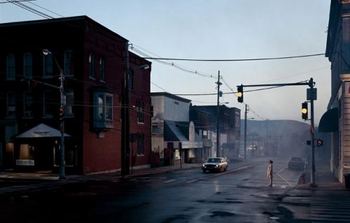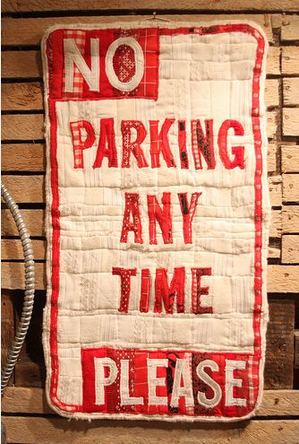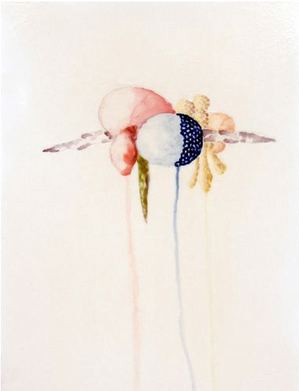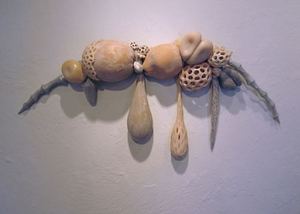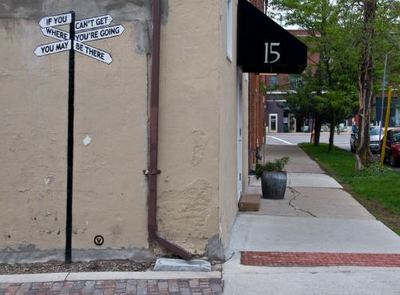Another Bouncing Ball: June 2009 Archives
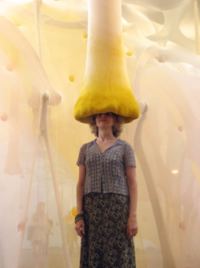 According to the Telegraph, more than 13,000 people applied to be living statues on Anthony Gormley's project for Trafalgar Square's empty fourth plinth, one hour each, night and day, for 100 days. Titled One & Other, it opens July 1 with 613 participants.
According to the Telegraph, more than 13,000 people applied to be living statues on Anthony Gormley's project for Trafalgar Square's empty fourth plinth, one hour each, night and day, for 100 days. Titled One & Other, it opens July 1 with 613 participants.The Telegraph was wrong about one thing. A fork-life truck will lift not just a "mixed bag to Britons" to temporary glory. Applications were accepted from around the world, including one from Seattle artist Ellen Ziegler. After her name came up, she raised funds for her trip via Facebook.
Ziegler:
I plan to expand my work with mirrors into a time-based interactive performance on the Fourth Plinth at 9:00 am UK time, July 24, 2009. Live webcams will broadcast in real time; there will be BBC and international media coverage.
In case you sit up nights worrying that the Chinese aren't quite grasping the whole capitalist thing, let this photo reassure you. These are Terra-cotta warrior shaped packets of chili sauce.
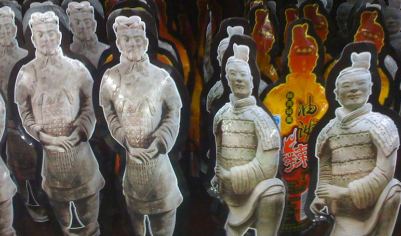 Unregulated capitalism in a totalitarian state might be good for packaging. But deprived of the dream of the common good without gaining anything resembling human rights, the people are a bit adrift, don't you think, Li Wei?
Unregulated capitalism in a totalitarian state might be good for packaging. But deprived of the dream of the common good without gaining anything resembling human rights, the people are a bit adrift, don't you think, Li Wei?Li Wei:
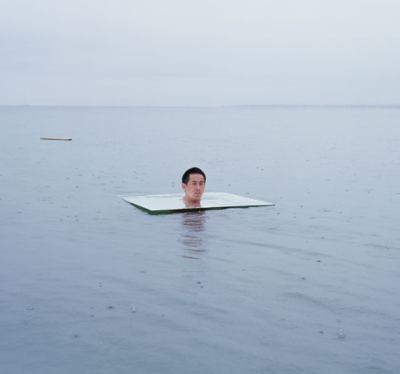
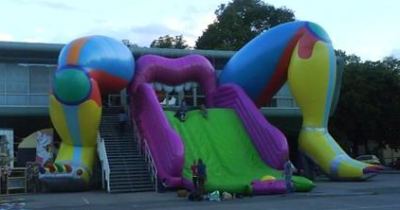 It's not a scandal, but unless it's by Niki de Saint Phalle, it's a rip off.
It's not a scandal, but unless it's by Niki de Saint Phalle, it's a rip off. Her Hon (through her sex), from Moderna Museet Stockholm, 1966:
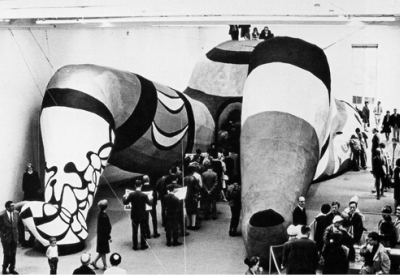 Her idea, her colors.
Her idea, her colors.Although SAM has owned the object since museum founder Richard Fuller purchased it in 1970, the museum says it has never been shown. (Fuller retired in 1973.) Not even Australian Aboriginal elders who are pressing the issue around the world knew of its existence.
SAM is not only returning the object, it volunteered to do so without being asked.
Why? Thanks to Margaret Levi and Robert Kaplan, who've been collecting in this field since the 1980s, SAM has a stake in the subject. It's one of the only U.S. museums with a gallery devoted to Australian Aboriginal art. The real motivator, however, is SAM's African art curator, Pamela McClusky. When I met her in the early 1980s, she had mounted an exhibit of traditional Ibo stools. Noticing what struck me as a lax security presence and the small size of the stools, I asked if she were concerned that one or two might be taken.
Not at all, she replied. The stools are spiritually protected. If anyone were foolish enough to steal one, he'd suffer before he came to his senses and brought it back.
A student of Robert Farris Thompson's, McClusky is not your ordinary art curator. Like Thompson, she embraces the meaning first peoples give the objects that they create. She is far more likely to see the central Australian Aboriginal object in question as elders see it, rather than in purely aesthetic terms.
Once the object came to her attention, it was as good as gone.
The wording of the press release has her stamp on it:
Secret/sacred objects of the type being returned are typically used in religious ceremonies by central Australian Aboriginal men. They are considered to be physical manifestations of sacred ancestral beings and as such have great spiritual power.
Not thought to have great spiritual power. The assertion is that they do in fact possess such power.
The National Museum of Australia will store the object temporarily while consultations proceed regarding its final repatriation.
While I haven't seen it, she didn't need to explain the title. Oliver Wendell Holmes' metaphor is so rooted in the American imagination that her two-word contraction carries the day.
Holmes:
The most stringent protection of free speech would not protect a man falsely shouting fire in a theater and causing a panic.Makes sense. The elegant image, however, supported a bad judgment and helped Holmes ride into history lauded for good sense he did not, in this case, demonstrate.
The Supreme Court opinion in question upheld a prison sentence given the pacifist Charles T. Schenck for distributing leaflets to World War I draftees. He urged them to say, without violence, hell no, we won't go. (Schenck v. United States, 1919). The fire of which he warned was not a delusion.
When writing Supreme Court decisions, art is good, but justice is better.
Among people with a professional interest in the arts, "Tutankhamun and the Golden Age of the Pharaohs," which opens today at the M.H. de Young Memorial Museum, will merely deepen the tarnish on the reputation of the Fine Arts Museums of San Francisco.More here. The first Tut wave in the U.S. in the 1970s reverberated in the art of the time. This time, the only response worthy of the high status of the subject comes from Brooklyn artist Ariana Page Russell, via Shaun Kardinal. Titled Pharaoh, it's a self-portrait as boy king.
 Just as Tut's body is an essential part of the touring package, Russell's patterns come not from paint but from welts. She explains:
Just as Tut's body is an essential part of the touring package, Russell's patterns come not from paint but from welts. She explains: I have dermatographia, a condition in which one's immune system exhibits hypersensitivity, via skin, that releases excessive amounts of histamine, causing capillaries to dilate and welts to appear (lasting about thirty minutes) when the skin's surface is lightly scratched. This allows me to painlessly draw patterns and words on my skin, which I then photograph. Even though I can direct this ephemeral response by drawing on it, the reaction is involuntary, much like the uncontrollable nature of a blush.

As a journalist and filmmaker, I am called upon by the Islamic Republic of Iran to respect the red lines. These "red lines" include belief and respect for the Supreme Leader and the savagely unjust rules of traditional Islamic law in my country. I am expected not to write or demand equal rights. I am not allowed to make any film without the permission and without censorship by Iran's Minister of Culture. If I did openly do all these things in Iran, I would be disappeared, tortured and raped. I would be killed as have so many women journalists, filmmakers and activists in Iran. Among those killed include Zahra Kazemi, the Iranian-Canadian photo journalist who was tortured and murdered for attempting to photograph and publicize brutalities committed by the Iranian regime.
This is Iran. This is what it means to live under Ayotollah Khameini and his goons. No change is possible while Iran is controlled by autocratic, fundamentalist religious despots who determine the laws of the land. There has been no real election. Candidates are all hand-picked and cleared by a central religious committee. It is a farcical imitation of the free nomination/ election process that we have pictured in the free world. There is no possibility that a secular, pluralistic, freedom-loving democratic person who loves his or her country can become a candidate to run for president (or any other office) in Iran.
More here. Meanwhile, inside Iran, artist/filmmaker Mania Akbari writes about the arrest of her 17-year-old son, grabbed for wearing a green armband. Badly beaten, he was released because she has serious pull.
 To Aliabdai and Moshiri, add Sonny Assu.
To Aliabdai and Moshiri, add Sonny Assu. Sonny Assu again, via.
Sonny Assu again, via.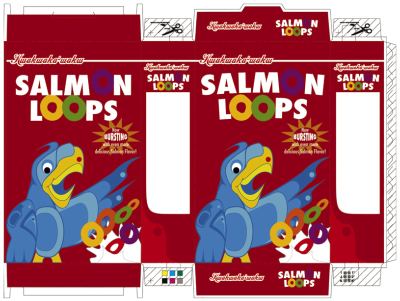 Jack Daws, TWO TOWERS, Chromogenic print of artist-made construction from McDonald's French fries and Heinz ketchup.
Jack Daws, TWO TOWERS, Chromogenic print of artist-made construction from McDonald's French fries and Heinz ketchup.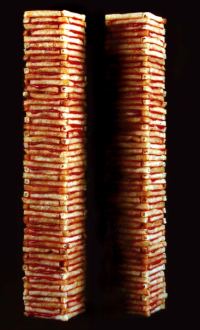
Ross Palmer Beecher, 7-Up Quilt
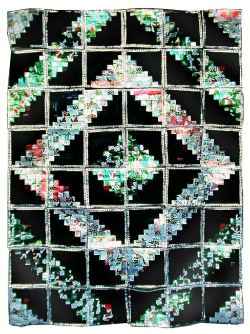 Roger Shimomura, The Asian Mind
Roger Shimomura, The Asian Mind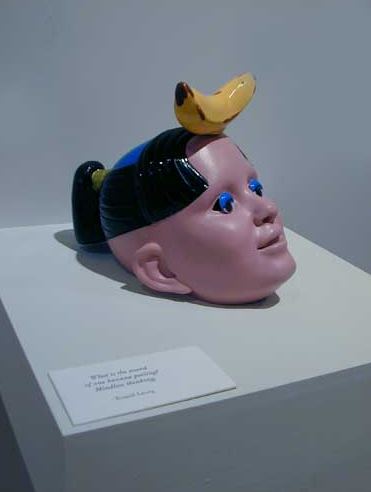 Shimomura again, EBay Citizen No. 1
Shimomura again, EBay Citizen No. 1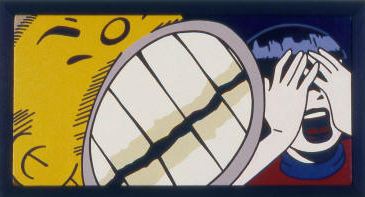 François van Reenen, memories of a white childhood in South Africa, Crying Cowboy #1
François van Reenen, memories of a white childhood in South Africa, Crying Cowboy #1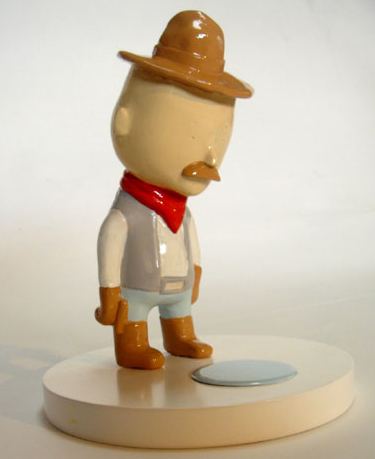 Rashid Johnson, Shea Butter Mountain
Rashid Johnson, Shea Butter Mountain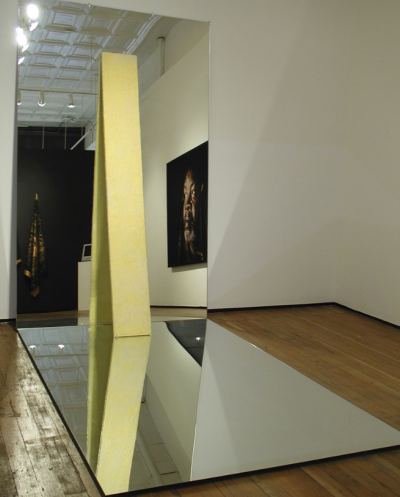 John Feodorov, New Age Native American mysticism
John Feodorov, New Age Native American mysticism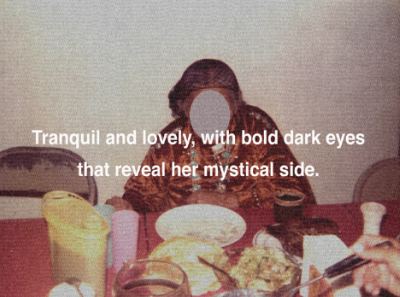 Nikki S. Lee - inserting herself into iconic America
Nikki S. Lee - inserting herself into iconic America This could be the endless thread. It's the essence of what artists do - Take an object. Do something to it. Do something else to it. One more packaging-worlds essential, although suggestions from others welcome.
This could be the endless thread. It's the essence of what artists do - Take an object. Do something to it. Do something else to it. One more packaging-worlds essential, although suggestions from others welcome.Tracey Moffatt:
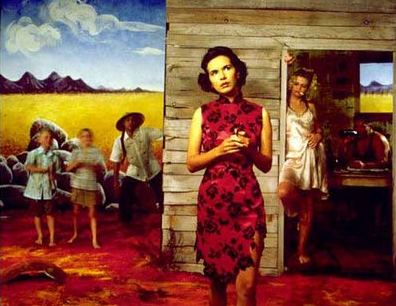
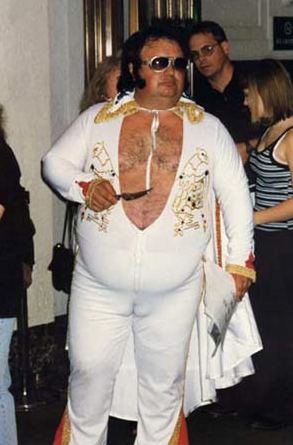
 Any museum director (and plenty of curators) who leave the job to
applause gets presents for the institution. Mimi Gates has earned her
share.
Any museum director (and plenty of curators) who leave the job to
applause gets presents for the institution. Mimi Gates has earned her
share.In her 14-year tenure as director of the Seattle Art Museum, Mimi Gates, 66, guided guided SAM through a major expansion as well as the opening of a waterfront sculpture park, what John Walsh, former director of the Getty Museum, called her "benign, beautiful land grab." She came to Seattle after 19 years at the Yale University Art Gallery, seven-plus of those years as its director.
With a doctorate in Chinese art history, her background is art rather than business. Under her tenure, however, the museum has been successful on both fronts. When she announced her retirement last year, Walsh said:
It helps if you're a fundamentalist, and she is. She believes in the basics of building the collections and mounting serious exhibitions. Expansions are great and nobody has done it better than she has, but she proceeds from sound museum ideas.Future plans include starting a Center for Asian Art and Ideas at the Seattle Asian Art Museum.
(Photo of Gates with Richard Serra by Joshua Trujillo/P-I. All other images from SAM.)
Today SAM announced a list of 20 gifts donated in her honor.
Highlights:
Pine and Rock and Lotus and Ducks, 1690s Bada Shanren (Zhu Da) Chinese, 1626-1705 Set of two hanging scrolls; ink on satin; 172 x 43cm each. (The Gates Foundation Art Acquisition Fund, backed by Gates' step-son and step-daughter-in-law, Bill and Melinda Gates, contributed to this gift.)


...as a man whose physical presence was first androgynous and then seemingly cyborgian, forcing his astounded public to puzzle over their assumptions about race, gender and age.Jeff Koons: Michael Jackson and Bubbles, 1998
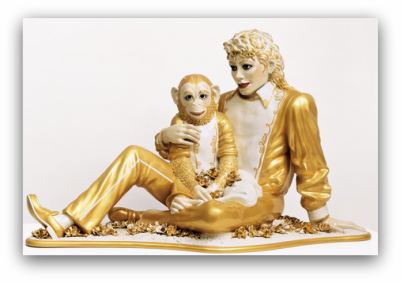 Christian Marclay: from Body Mixes
Christian Marclay: from Body Mixes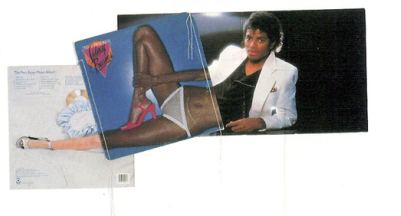 Samantha Scherer: Just his eyes
Samantha Scherer: Just his eyes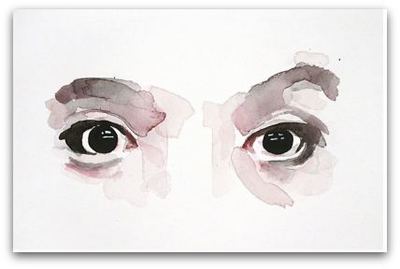 As he saw himself: Robot Head (1 & 2) from Moonwalker:
As he saw himself: Robot Head (1 & 2) from Moonwalker: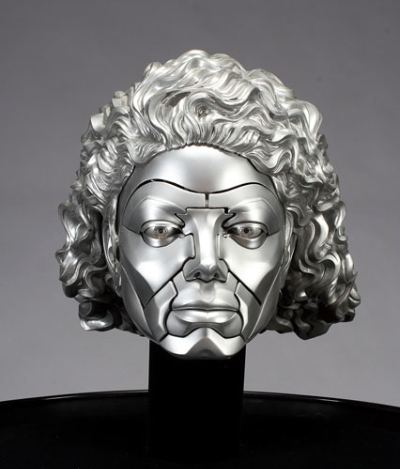
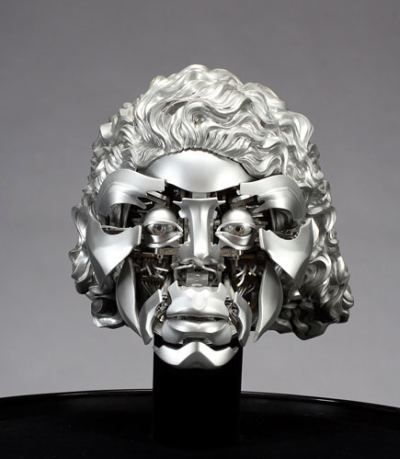 Another way to see Jackson as he saw himself: Turn him into a toy, a la
Another way to see Jackson as he saw himself: Turn him into a toy, a la 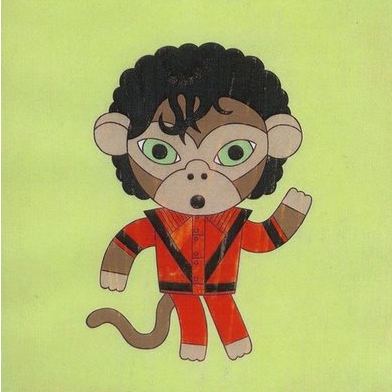 Mark Flood goes for the benign freaky:
Mark Flood goes for the benign freaky: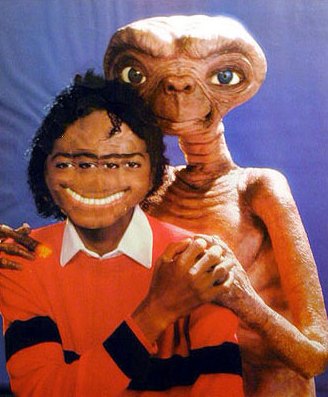 RIP to the dazzling genius of rhythm and pop soul. There is, however, and elephant in the room, and that rough beast has nothing to do with the moonwalk. As Chris Rock said, "We loved him so much we let the first kid slide."
RIP to the dazzling genius of rhythm and pop soul. There is, however, and elephant in the room, and that rough beast has nothing to do with the moonwalk. As Chris Rock said, "We loved him so much we let the first kid slide." Banksy here, putting a face on the (in fairness, unproven) problem. More Jackson-in-art here.
You go to war with the army you have, not the army you might want or wish to have at a later time.Donald H. Rumsfeld, Dec. 14, 2006
Ben Jackel, stoneware and beeswax, 2008
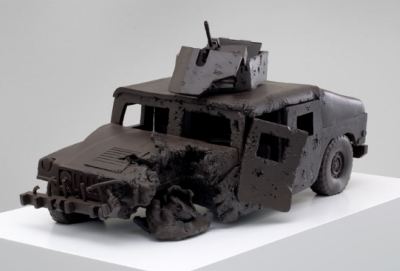
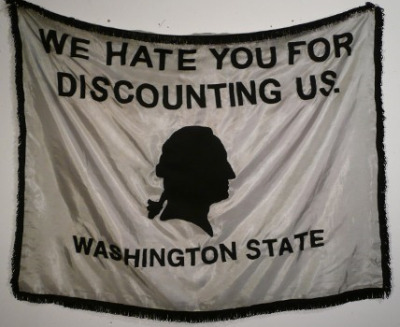

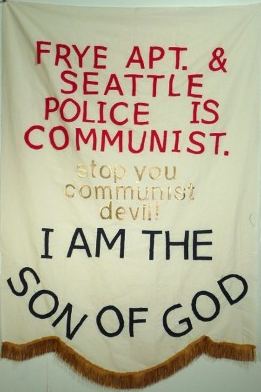 Jack Daws is into home craft. Below, he pickles old glory.
Jack Daws is into home craft. Below, he pickles old glory.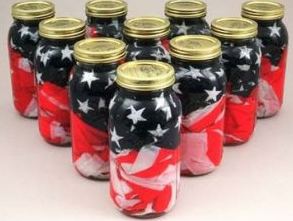 Costa Vece - from the coffin of lost causes.
Costa Vece - from the coffin of lost causes.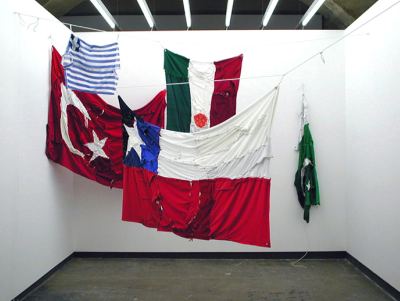 Harmon de Hoop- red, white and blue product under a red, white and blue grid.
Harmon de Hoop- red, white and blue product under a red, white and blue grid.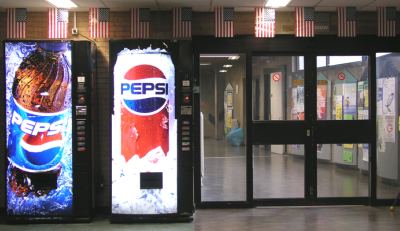 Ed Templeton - American Pride for Sale. Looks like a good thing to me.
Ed Templeton - American Pride for Sale. Looks like a good thing to me. 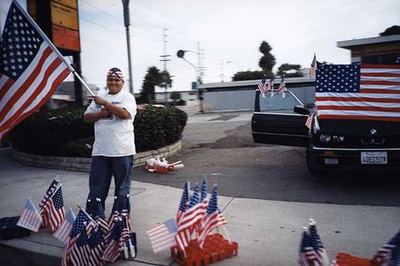
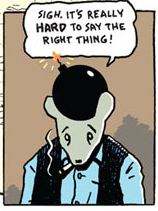 He's referring to what Danish Prime Minister Anders Fogh Rasmussen called his country's worst international crisis since World War II, here. In Seattle, only the Stranger ran the cartoons in question.
He's referring to what Danish Prime Minister Anders Fogh Rasmussen called his country's worst international crisis since World War II, here. In Seattle, only the Stranger ran the cartoons in question. 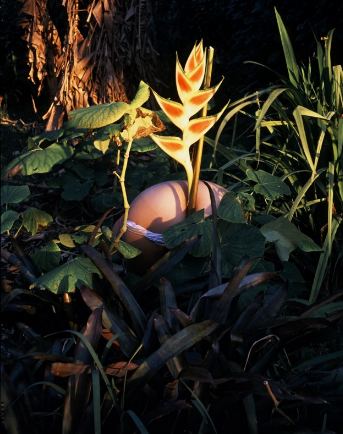
Both exhibits open tomorrow. (Target Practice reviews to follow.)
Wyeth's admirers try to insinuate him into the thick of things. For the artists in Target Practice, however, he wasn't on the firing range. Rauschenberg erased a de Kooning. Andrew Wyeth? His name did not come up.
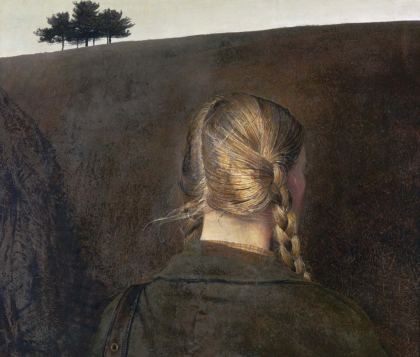 Wyeth backed himself into a corner of a particular place rooted in land and family and painted his fear of the world. With a desperate and dry exactitude, he documented every inch of what mattered to him. He aimed for sentimentality but didn't get there.
Wyeth backed himself into a corner of a particular place rooted in land and family and painted his fear of the world. With a desperate and dry exactitude, he documented every inch of what mattered to him. He aimed for sentimentality but didn't get there.His idea of the beautiful is dead-on-arrival, but his depiction is the equivalent of Miss Havisham preserving her cake.
Take Farm Road, above. (1979, Tempera on masonite, 21 inches high by 25 1/4 inches wide. Private collection.) Rembrandt-light shines on the greasy hair of his model, gray and brown at its roots and brass in its braids. Is the farm road in the title the rigid path of her hair? There is no other.
The rusted iron ground that rises in front of her blocks her progress. She's right where he wants her, under his surveil, every hair on her head counted. Above, where she isn't looking, the flat light of another dull day rises against a horizon line broken by a cluster of trees.
Wyeth is the American version of Edvard Munch, literal where Munch is flowing but tapping into the same emotional territory. Wyeth's scream is that there is no scream. He's the painter of a vast suppression, what it took for him to pass for normal in the countryside.
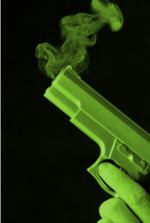 Death does not have to hang heavy in your head for you to be a fan of Obit. (I'm a fan, and I'm singing a happy tune as I type this. Worms crawl in, worms crawl out...)
Death does not have to hang heavy in your head for you to be a fan of Obit. (I'm a fan, and I'm singing a happy tune as I type this. Worms crawl in, worms crawl out...)Fellow AJ blogger, Jeff Weinstein, contributes to the site,
All that is by way of saying Obit's Top 10 List of Stupid Death Tricks is not just anybody's death-trick list.
Number 3, for example:
A prop can still be a deadly weapon. Actors on Hollywood sets are routinely warned to be careful with guns used as props, but in 1984, Jon-Erik Hexum, a star of the CBS action series Cover-Up, pretended to play Russian roulette by putting a blank-loaded .44 Magnum to his temple. "Let's see if this will do it," he reportedly said, and pulled the trigger. The burst of hot gas fired at close range penetrated his skull.I'd like to read a top ten list of stupid death tricks that didn't work. Chris Burden in his reckless youth would loom large on it, when he attempted to electrocute himself, and had himself shot, nailed to a VW bug and stuffed into a sack left in traffic. The trick here, in the format of a top 10 list, would be to convey to an undifferentiated audience why everything he did continues to matter so much, to not make a joke out of some of art's most soulful moments.
Anne Mathern
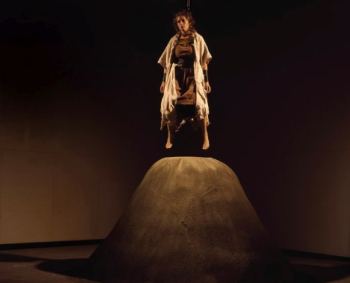 Mandy Greer
Mandy Greer 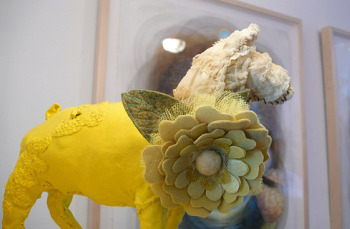 Alison Brady
Alison Brady 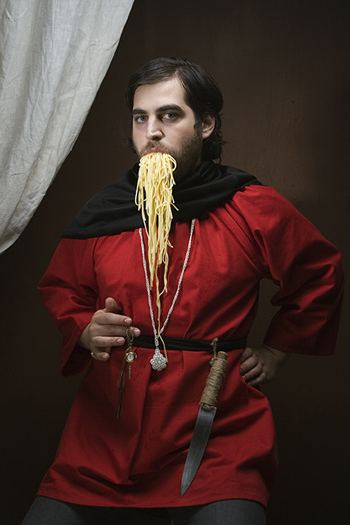 Titus Kaphar
Titus Kaphar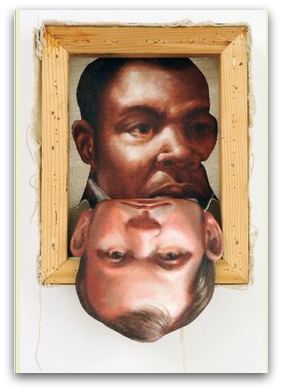 Dan Webb (Hold)
Dan Webb (Hold)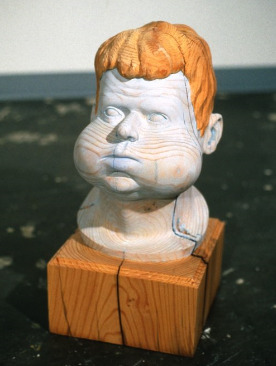 Mike Simi (Self-Portrait)
Mike Simi (Self-Portrait) Christian Van Minnen
Christian Van Minnen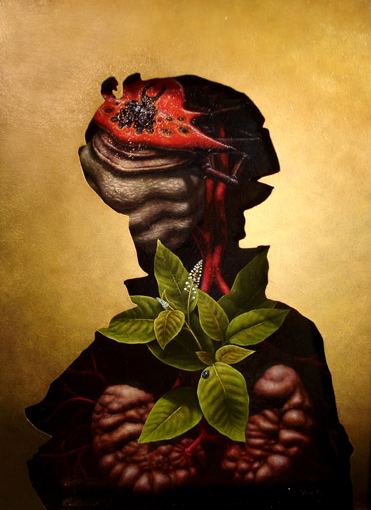 The answer is, of course, Mr. Elaborately Ceremonial.
The answer is, of course, Mr. Elaborately Ceremonial. 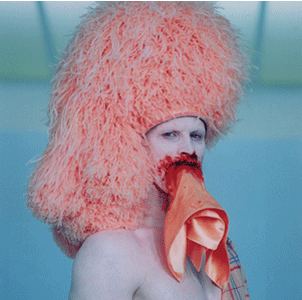
Either way, art continues to bloom, even in unlikely places.
Paula Wilson
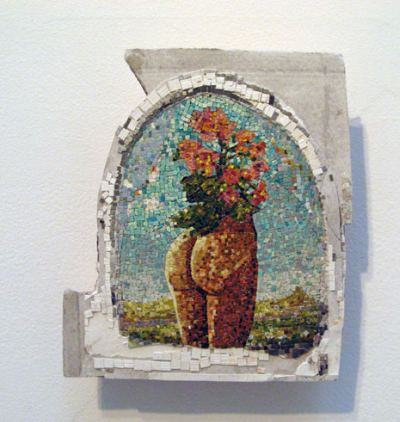 Ellen Altfest
Ellen Altfest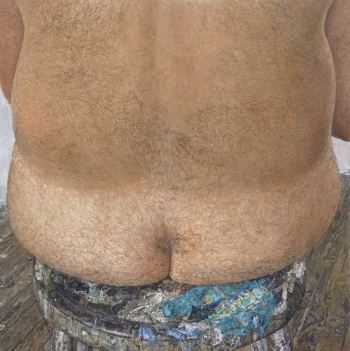 Alison Brady
Alison Brady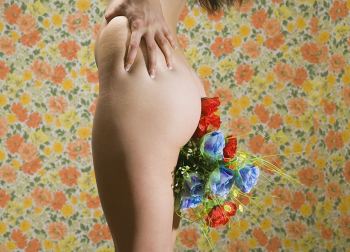 Jennifer Zwick
Jennifer Zwick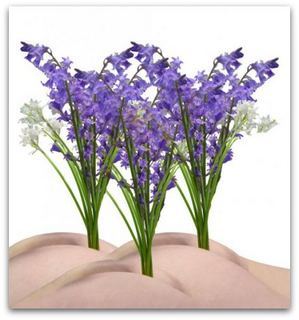
More on Huang Hsin-Chien here.
Nathalie Djurberg, currently at the Frye.
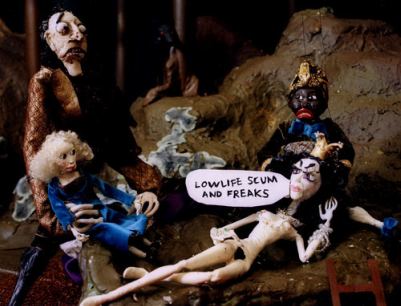 With a jet-stream jolt of girl-in-charge, Djurberg's puppets have a hard on for Manet as Travis Bickle.
With a jet-stream jolt of girl-in-charge, Djurberg's puppets have a hard on for Manet as Travis Bickle. All the animals come out at night - whores, skunk pussies, buggers, queens, fairies, dopers, junkies, sick, venal. Someday a real rain will come and wash all this scum off the streets.Mel Ramos did his Olympia, and so did Rashid Johnson, here. Talk about pregnant with cultural possibility.
So then, because you are lukewarm, and neither cold nor hot, I will vomit you out of My mouth. (Revelation 3:14-22)Titus Kaphar vomits history. He tars, feathers and tears it up. He peels it off, like sunburned skin. He allows it to leak through surface paint slathering, first eyes, then mouth: the white behind the black and the black behind the white, the racial stew of our collective story.
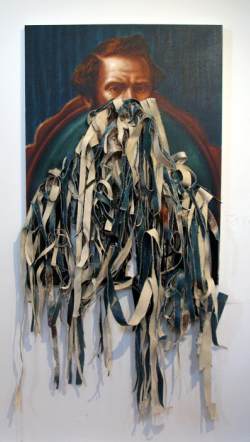 Seen in reproduction, his paintings can pass for tricks. First he makes copies of the past, then he destroys them. In person, however, the intensity of his paint handling shines through its violations.
Seen in reproduction, his paintings can pass for tricks. First he makes copies of the past, then he destroys them. In person, however, the intensity of his paint handling shines through its violations.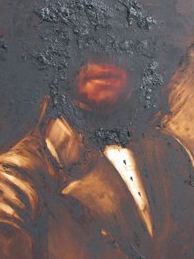 If the past awoke and walked down the street, we'd bar the door, but portraits that survive to represent various times and places tend to be lovely.
If the past awoke and walked down the street, we'd bar the door, but portraits that survive to represent various times and places tend to be lovely. We study the lace at her throat, the sword at his hip, the polished furniture behind them.
Kaphar honors this house by burning it down. He upends it. We see it, finally, painfully, through the lens of the present, what we know about the old and the new, not just figureheads standing in the boat but the muscle at the oar.
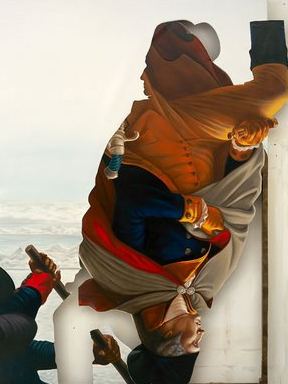
In mainstream food criticism, if you to eat with a restaurant critic, you'll get a lecture ahead of time on what not to say and what you're responsible for ordering.
Critics want to sample the menu without being obvious. The main thing you can't say? That you're eating with a restaurant critic. The whole premise of a review falls apart if the restaurant knows a critic is on the premises. The critic will be favored (duh), which means the meals s/he writes about are not the meals served to just anybody. That's why critics wear big hat and sunglasses in photos, when photos exist at all. They pay cash or use credit cards in somebody else's name.
This just in from the citizen journalist who now functions as the PI's restaurant critic. Click restaurants/dining under A&E, and you'll get him.
Two of my co-workers have basically moved into Volunteer Park Cafe (link added). They work out of the cafe many days out of the week. This adorable little cafe located in an otherwise residential portion of the Capitol Hill neighborhood in Seattle is quite homey, so it's no surprise they're making it their workday "home". In addition, as I joined them and another friend for lunch, after we ordered, one of the "regulars" informed the owner that I'd be writing about my meal.His friends didn't get the shalt-not rap when it mattered, ahead of time, and he photographs his food. Yes indeed. Restaurant folks are not dopes.
In addition to all the food we ordered and paid for, a plate of free cookies and cake magically appeared towards the end of our meal. I make it a rule not to let restaurant owners know why I'm there and I pay for my food. I chastised the informer appropriately, but I did eat those cookies. My general philosophy is that I try to be as fair as possible. I don't ask for special treatment, and I don't expect any. That said, I do photograph my food and restaurant folk are not dopes.
Real restaurant critics have their own eccentricities. When he was at the PI, Tom Sietsema, now at the Washington Post, used to follow a few small, well-considered bites of any item by dousing the remainder with salt and pepper. It's how he ate out almost every night and kept his lovely figure. I believe restaurants in Seattle were on the look-out when waiters cleared plates for those encrusted with condiments. If it was the salad, they could come back big with the entrees and desserts.
The exception is contemporary. If an exhibit on a contemporary theme is on the road, rare is the regional museum able/willing to integrate the home grown with the imported.
Why? If done badly, it's better not done. Good examples of Picasso exist lots of places. But faith that artists in a particular region can succeed in a global context is harder to come by.
The Puppet Show from the ICA is a hit at the Frye. That's great, but why not spread that applause around?
Take Seattle's Mr. Puppet, Warner Blake, veteran of innumerable street fairs and puppet dinner theaters. No room for his orchestra on the back of a turtle, his suitcase-sized marching band?
It would have been easy to make a little.
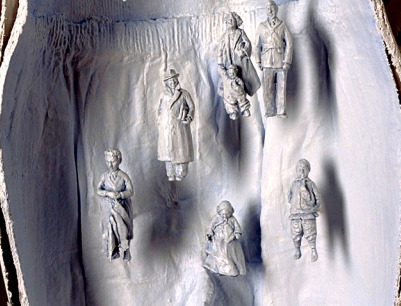
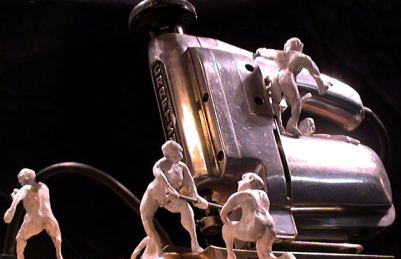
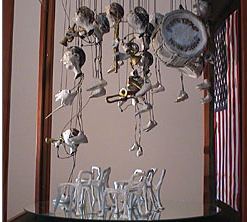
Regina, I still love you, even though your comments about me are preposterous.
This post - Dave Horsey derides his former (fired) PI colleagues - remains big in journalism circles, although most of the discussion is not on this blog. But good responses continue to trickle in, from the irritated (Emily White, whom I think might have intended to respond to this post, which referred to her PI tenure) to the amused (Casey Corr).
White was at the PI for (roughly) a hard half-a-year. Corr was on the staff when I showed up in the early 1980s, put in close to a decade and moved on. Point is, Corr and I (and Horsey) go way back.
Corr:
To readers of (Another) Bouncing Ball: I'm going to slip this comment in weeks after the original posting in the hopes that only readers but not Regina Hackett see it
First, I sat next to Regina Hackett back at the old P-I on Wall Street (where the Globe spun for a reason) and not once did she say she found me brilliant. So that sets me apart from Emily White. Regina never even called me semi-smart.
Second, Dave Horsey's tactic of telling a critic that he loves her is the first thing he learned on the (University of Washington's) Daily, back when he and other Dolly Parton-style big hairs were chasing Charles Odegaard trying to slip out the back door of the Administration Building at the University of Washington.
In fact, Horsey yelled "I love you" to Odegaard in a shameless effort to get an exclusive. It worked. Odegaard stopped and thus Horsey gained his first Pulitzer.
As for Horsey saying he loves Regina Hackett, I can only say, get in line, pal. I loved sitting near Hackett so much that when I turned coat and went to the Seattle Times, I graciously allowed Regina to have my old phone number, 448-8332. (That number now rings into a dictation machine that transcribes comments into a blog called 8332.)
Later, I tried to get Dave to join me at the Times but he had an understandable concern about the chilly water that flowed in the veins of the editorial-page editor of that era. Finally, if ArtsJournal decides to throw a fancy party for its advertisers, I'm quite willing to give the speech and celebrate the shock of the new, or the new new thing, or the value of hits or eye balls, or whatever puts digital journalism on the cutting edge of cutting costs as the mass medium turns mini, along with the pay checks.
Have tux, will travel. Casey Corr
P.S. If by chance, this posting is a duplicate, I apologize. I got an error message when I tried to post the first version and lost my draft. The blogging world has its cruelties.
I'm afraid of heights. Titled Exit Ramp, the piece cut the theater in half and gave those traveling on it a new view of the space below. What that new view was I can't say. As my knees locked, I focused on a woman in a wedding dress with gray ashes on her white-washed face who was leaning out from the balcony above and singing Mozart.
The song and the sight of her (old-worldly with a hung-in-the-closet, suppressed glamour), distracted me from an interview that came to mind at this most inopportune moment. In it, Brendan Kiley asked Lead Pencil's Annie Han about her fears for Exit Ramp.
.
The eternal fear of structural collapse and bodily injury on any project bigger than a man is tall.Exit Ramp is part the Free Sheep Foundation's Moore Inside Out, a Saturday-night only project with 50 Seattle artists and performers that treated the whole theater as a gallery, including stairs and corridors, basement and backstage.
Thousands showed up. As Kiley wrote in his preview,
Free Sheep roots out forgotten places, their histories and memories, and distills them into potent, one-shot events that leave indelible burns on the city's collective memory. Free Sheep happenings are mayflies on fire.Lines curved around the block to get in. Once inside, there was more waiting. Few appeared to have any idea of what they were waiting for. People joined a line and shuffled along in a collective mood of happy-to-be-surprised.
Not everybody, of course. I ran into an art historian who said, "Typical Seattle mediocrities." She was waiting for her yoga teacher to perform and looked as if she were holding her breath.
The crowd was the thing. Seattle is frequently a place where an audience is hard to come by, which means this audience - everybody there for performance art - was heartening to itself.
Something important got lost in the self-congratulations, however.
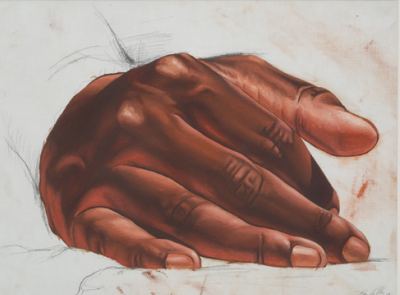 The old rough and tumble: Ed Templeton (with stigmata)
The old rough and tumble: Ed Templeton (with stigmata)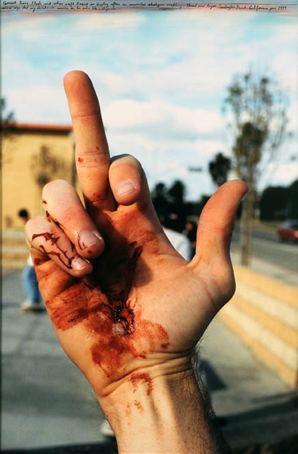 Their merger: Debra Baxter - Brass Knuckles/Tongue (Hurts So Good)
Their merger: Debra Baxter - Brass Knuckles/Tongue (Hurts So Good)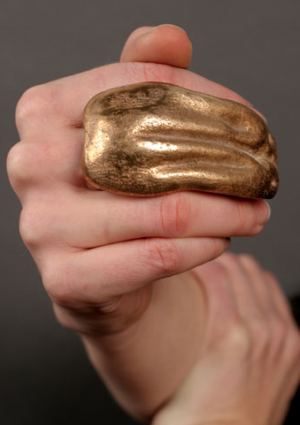
The word "complete" saves the sentence, but not by much. Subtle undercurrents are not the ocean. A bottom is not a top, and a puppet directs nobody's action, not even its own, especially not its own. One person peels the grape, the other eats it: When I say do it, hop to it.
But rules of puppetry are not rules of art. Art is not limited to the taking and/or giving of orders. It's about doing what you can defend, which is, in this show, to muddy the waters.
Bruce Nauman's Violent Incident (Man/Woman Segment) is puppet tennis, with actors. If violence is the ball, they bat it back and forth; both victims and aggressors.
Philippe Parreno and Rirkrit Tiravanija use puppets as art world stand-ins. Once artists establish a brand, can't they disappear inside it, letting their puppets do the interviews? Who's the puppet in this case, the figure sustained by strings or the journalist taking the interview seriously?
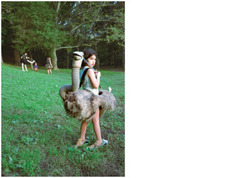 In Guy Ben Ner's Elia: A Story of an Ostrich Chick (2003), the artist, his wife and two children descend the evolutionary latter to enact a drama that accurately portrays their lives - evolution as a slide guitar.
In Guy Ben Ner's Elia: A Story of an Ostrich Chick (2003), the artist, his wife and two children descend the evolutionary latter to enact a drama that accurately portrays their lives - evolution as a slide guitar.In Kara Walker's Testimony: Narrative of a Negress Burdened by Good Intentions, whites are slaves whom blacks generously claim, only to be exhausted by the whites' inability to rise to the rudiments of civilized behavior. It's a shadow play in video, but not a simple exchange of roles. The whites are burdened by white stereotypes. In the end, power does not corrupt, and oppression does not ennoble.
Nayland Blake's Tabletop Production of the Philosophy in the Bedroom is a history of the old world, its decadence and freedom preserved in fragments. Annette Messager's Faire Paradeis a pair of child's pajamas riddled with colored pencils - St Sebastian for preschoolers.
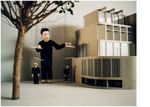 If Pierre Huyghe's "This is not a time for Dreaming" (with Puppet Heap) were the entire show, it would be worth seeing, even though the narrative cannot be gleaned without explanation. The narrative doesn't matter. What does is the clear, haunting beauty of each scene as it slides from present to past. Art can break your heart.
If Pierre Huyghe's "This is not a time for Dreaming" (with Puppet Heap) were the entire show, it would be worth seeing, even though the narrative cannot be gleaned without explanation. The narrative doesn't matter. What does is the clear, haunting beauty of each scene as it slides from present to past. Art can break your heart. That leaves, among a host of other terrific entries, the obvious one, reproduced on the cover of the catalog and with nearly every review: Dennis Oppenheim's Theme for a Major Hit (1974).
To answer his own question - how to make performance art without being there? - he created a cadre of his own mini-me's. Dressed in hip suits, they assume various unruffled positions till a timer goes off and they dance.
Puppets are rarely cool. They're fall guys who are beat on the head but rise again, bits of their stuffing clinging to the cugel. Oppenheim's make Andre Benjamin look awkward. They're light on their feet, with a heavy-metal gleam in their gun-gray eyes.
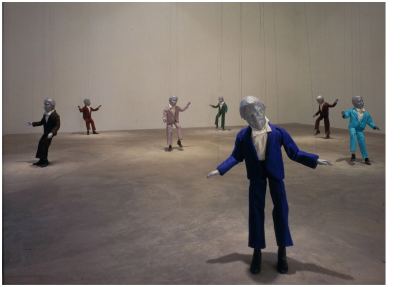 Jaymi Durate, a Frye guard who's spent weeks with them, winces when the bell sounds and they thunder into action. She says their charm wears out, and she could be right. Give them five minutes and leave, on the other hand, they're hot forever. Her best-of-show is Pierre Huyghe.'s. The more you see it, she said, the better it gets.
Jaymi Durate, a Frye guard who's spent weeks with them, winces when the bell sounds and they thunder into action. She says their charm wears out, and she could be right. Give them five minutes and leave, on the other hand, they're hot forever. Her best-of-show is Pierre Huyghe.'s. The more you see it, she said, the better it gets.(Previous here and here.)
The Frye has a tight crew. Other guards are covering for him.
He's not the only one who backs away as if the gallery's a gun. Loehr's pair of talking hands with rhinestone eyes and mouths that move in the crack between thumb and palm recite a text that anybody who's not extraordinarily lucky has already heard and/or spoken.
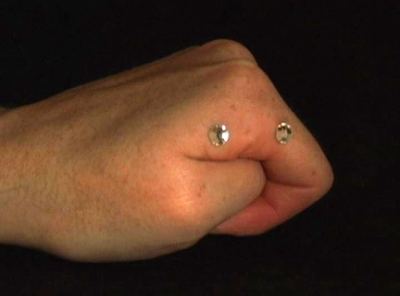 Only one hand talks, and it's a massive utterance.
Only one hand talks, and it's a massive utterance. In their search for closure, the garrulous cover their targets in wounded projections. They lay out what the other did wrong and how (even now) the rift can be healed (baby, don't go), if only the silent would speak in confessional detail and profess revived devotion.
Loehr's silent, soon-to-be ex expresses misery with small, downcast quivers. No frog spreadeagled in a high school biology lab suffers more. The text tells itself through hands manipulated into expression, which makes those hands puppets. The videos that feature them are in The Puppet Show, a traveling exhibit from the ICA.
At the Frye through Sept. 13. Previous here, more to come.
I should have listened to Jen Graves, review here. (Mine in multiples soon to follow.)
The Puppet Show is killer good, and so is its catalog. Catalogs for crowd pleasers are either too jolly or too academic, good for their show lists, images and quotes from artists. This one, like Poussin, can truly claim to have thought of everything.
Below, jewels plucked from its various crowns, otherwise known as quotes from essays, beginning with the anchor piece by ICA curator Ingrid Schaffner, which provides an essential history of.
The art of bringing dead things to life is how Kiki Smith, who was once a busker with a Punch and Judy show, relates her work as a sculptor to puppetry. Or half-life, since part of what makes puppets so compelling - and, to many minds, creepy - as objects is that they always appear to be as much dead as alive.
The puppet that opens its eyes after everyone has gone to sleep...
(About Calder's Circus, from 1961:) The sight of a big old bear of a man playing with tiny childish objects ... encapsulates a lifetime's effort to make art as gratifying as a toy.
fingers tangled in strings...
In the creation of art, it is the puppet one makes of oneself that is most important. (Harold Rosenberg)
Jane Taylor: Big points for resuscitation of Stanley Kubrick's 2001: A Space Odyssey, which was always too big-idea for me, and whose virtues have receded through the lens of nephews and nieces, who unanimously reject it.
'Stop. Will you. Stop Dave. Will you stop Dave. I'm afraid. I'm afraid Dave.' These are not questions, nor are they appeals. They are chains of signifiers.
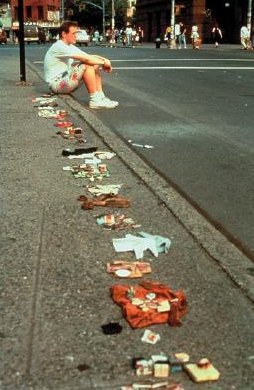
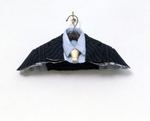
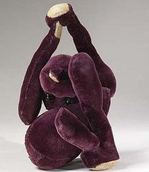
My Papa's Waltz
The whiskey on your breath
Could make a small boy dizzy;
But I hung on like death:
Such waltzing was not easy.
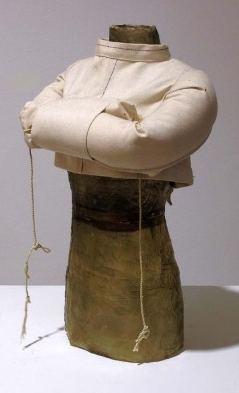
The hand that held my wrist
Was battered on one knuckle;
At every step you missed
My right ear scraped a buckle.
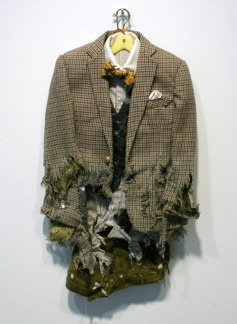
You beat time on my head
With a palm caked hard by dirt,
Then waltzed me off to bed
Still clinging to your shirt.
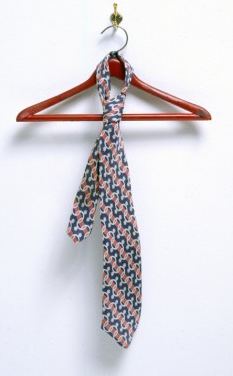
What happens to roughly two-dozen paintings, drawings and sculptures by veterans of the Northwest mainstream that Chase decided not to keep? (Including Alden Mason, Joseph Goldberg, Jeffry Mitchell, Robert Sperry, Frank Okada, Doris Chase and Gaylen Hansen.)
Earlier this week, Chase staged a give-away. Museums were invited to choose what they wanted, followed by other selected nonprofits. The Seattle Art Museum confirmed that it participated but declined to say what it picked, as those choices are dependent upon approval from an acquisitions committee.
Rumor has it SAM chose the Sperry and nothing else. Other museums didn't want to confirm the giveaway at all, as they believe Chase wants to remain anonymous.
Chase could have sold everything anonymously and cashed the check, although the gap between the work's appraised value and current market value could be large, making tax deductions a better financial option. Whatever the motive, there are worse things that could happen to art than landing in a museum.
Board member and donor (with his wife Helen) to a variety of Seattle arts groups, including the Seattle Art Museum, the Henry Gallery and Cornish College of the Arts, Gurvich's lasting legacy might be a hideous pair of woven, window-blind style metal sculptures that rise 22-feet out of the water at the west end of the Evergreen Point Bridge, which connects Seattle to its Eastside suburbs.
 I wrote a story for the PI when they were installed in 2002. Here's a recap:
I wrote a story for the PI when they were installed in 2002. Here's a recap:Seattle's rules for who can place what art in what part of the public sphere are rigorous, and yet Gurvich triumphed over all that to install his creations in a prominent spot, where 130,000 cars drive by them each day.
Here's the good part: He didn't say he was the artist to anybody who needed to approve the placement. Instead, he spent a year getting a permit from the Department of Transportation and the go-ahead from the majority of nine community clubs and six cities on Lake Washington.
They didn't ask, and he didn't tell.
Tom Lentz, Department of Transportation assistant regional manager for maintenance and traffic:
I thought Max was the patron, and he had an artist working with him. I guess I should have asked, but I'm an engineer. I looked into the engineering issues. Rarely do people offer to give us something. I found it refreshing. Max got support from the city's art commission, and the state's, too.
Actually, he didn't. The state, King County and Seattle arts commissions all said they had nothing to do with it.
When Lentz went back to his files to figure out what happened, he found that the DOT contacted both city and state arts commissions, and was told by each it wasn't their baby. Not on city property, said the city. Not through our funding sources, said the state.
The sculptures, titled Aurora Borealis, look like early '60s room dividers from a suburban den joined to make inverted pyramids. Seven years after their installation, their kitsch exuberance has run its course.
Seattle curator Vicki Halper:
You have to hand it to him. He did it all. He should have been stopped, but he did it all.
- John Lennon
Andrew Miksys:
Miksys won his first bingo game at 11, collecting $280. In high school he delivered a newspaper his father published, Bingo Today, to veterans halls, fraternal associations, churches and sports clubs in Seattle.
He knows the people he photographs in bingo halls, most of whom are dead and don't know it. The routine of the game keeps them in a pretense of motion. They stare are their cards the way the empty eye sockets of skeletons stare into eternity.
Below, their stash.
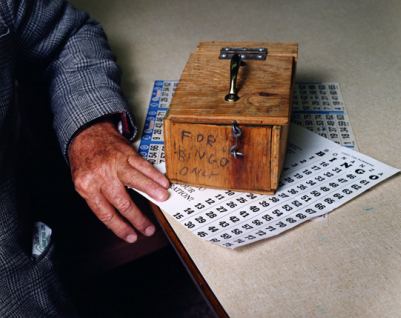 Matt Browning:
Matt Browning: Politicians infantilize the audience by reducing its members to first names and jobs, as if everybody is a waiter in a cheap restaurant, always on duty. (Joe the Plumber.) Artists do the reverse. Instead of gassing up a stereotype till it rises like a parade float, they use absurdist intensity to bring it to ground where it can be examined, ridiculed, celebrated and/or fractured into the particular.
Take Matt Browning, who explained himself in his debut exhibit at Seattle's Crawl Space late last year:
Men typically engage in bizarre competitions and intrepid behavior during their lives as a means of bolstering machismo and camaraderie. Instituting male pedagogy, identity and peer acceptance in suburban America can, for example, take the form of climbing the tallest tree as a child, asserting athletic prowess in adolescence, and winning reckless drinking competitions in early adulthood. My work illustrates the simultaneous presence of lunacy and beauty in these types of testosterone-laden behaviors.He digs to the root of male desire and finds it wrapped in baseball, beer, pot, skate boarding and the blunt end of taking things apart:
Leave no trace, review here.
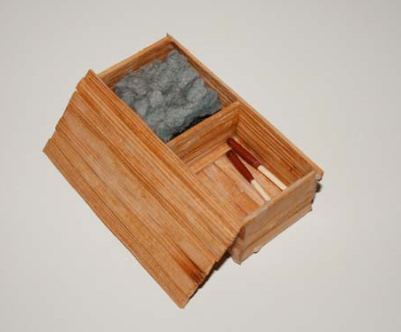 Liz Magor:
Liz Magor:When she was a child, she liked to slip into a forest near her home in search of a kid-size weasel hole. She thought if she lived there with a dog and a bag of potatoes, the silence of the natural world would replace the ruckus in her head. Her work is about the folly of aspiring to be in a hole, and the cultures that become one.
Hollow
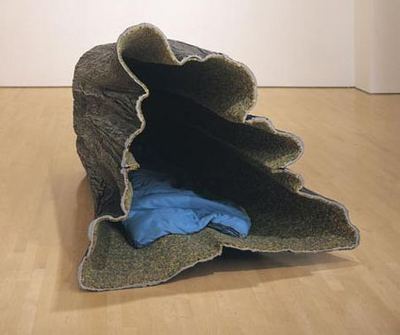
Inside a series of small black boxes Daws sealed a variety of drugs, from crack cocaine and crystal meth to ecstasy, heroin and LSD.
Partially, they are a tribute to Robert Morris' box sculpture from 1961, Sculpture With the Sound of Its Own Making, as well as Charles Ray's Ink Box from 1986, which wasn't a box but a vat of black ink. Those who touched its surface expecting something smooth and hard came away with a record of their infraction on their fingers.
Daws' infraction is an inside job. Who is in possession of the drugs, and who is the pusher when no one can lay hands on the substances in question (assuming they're really there) without destroying the art?
Felony Sculpture
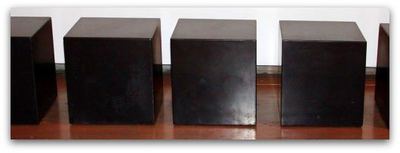
Fritz thinks inside the box, where she finds fragments of your inner life. When you were otherwise engaged, what was private became public and subject to experiment. Her merger of science and art involves video, mechanical contraptions, cast-polyester molds and a tendency to surround images with thick slabs of silence.
Like Larry Bell, her boxes are all about light, but unlike his spare volumes that trap light on their surfaces through a variety of coated films, her light needs the light in the larger room shut off to be seen at all. In the dark, when her fuzzy and uncertain pulses are the only illumination, they slide around you and take you in. In Section 4, a cat's shadow appears inside a box, lit by the milky glow of her video screen. The cat hesitates at the locked door and bows its head.
Section 4
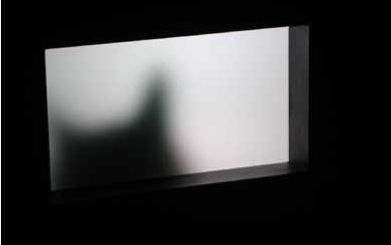
Click to enlarge. (Previous from me, Breasts at work and play here.)
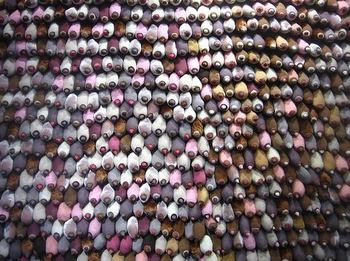 Topping the charts (again): Holland Cotter with his review of Light of the Sufis, here. Cotter is where I go to shop for images.
Topping the charts (again): Holland Cotter with his review of Light of the Sufis, here. Cotter is where I go to shop for images. Two from Sufi review: A 17th century Indian painting he describes as "an ego reduced by love to an ash on the arm of God." Nobody with as wide a view of art writes better:
A Koran page handwritten in light -- that is, in gold and silver inks on a sheet of parchment dyed deep blue -- is the exhibition's oldest work, dating from the 10th or 11th century. Seen by candlelight, the words, which describe the rewards of Paradise, would have glinted against the dark ground like constellations in a night sky.Also, Cotter on Giacometti, here:
These portraits are laborious, noodling things, their lines repeated over and over as if Giacometti were determined to create something solid from nothing, then to obliterate that something. Far more relaxed -- and surely Giacometti drew as compulsively as he did to relieve tension -- are the drawings that look incidental, on the fly: an empty studio interior, apples in front of a window, a pot of tulips, a tree. Heaviness lifts; anxiety is dispelled. The faint lines of the tree fly outward and upward like flames, evidence of a lightened-up, fly-away artist that some part of Giacometti may always have wanted to be.
Most dutiful plod: Kenneth Baker's review of Lords of the Samurai. He tells anecdotes from the catalog and calls it a day.
Also insupportable: Baker's contention that Ansel Adams tops Georgia O'Keeffe in SF exhibit. No matter what's on view, this isn't possible. Baker doesn't bother to try to prove the impossible either. He just asserts it. What's happening to one of the best art critics writing inside the dying empire of a newspaper, or, what's your frequency, Kenneth? Working for a living, taking what you're given? Your slumber-while-typing depresses.
Dress up the skin of your life: With infections, here.
The cruelest kind of cute: Thu Tran's Food Party. Birds doing her bidding get tricked into the stew pot on TV.
Speaking of food and art, Toi Sennhauser is a deeper sea diver. At art festivals, she has served bread baked with her vaginal yeast as starter, here, and made edible candy portraits of her family, here. (Her husband is a stick-to-your-teeth kind of guy, and her mom's got a sour exterior.)
Energy in the technicals: Paul Levy gets specific about Howard Hodgkin, here.
Verbal tennis at the Houston Chronicle: Douglas Britt gets it right in a platformed response to The Art Guys, sadly, here and here. How do I know, since I didn't see it? That's the beauty of video documentation, here. If the AG of the 1980s met the AG of today, the former would tell the latter to stop messing with the legacy.
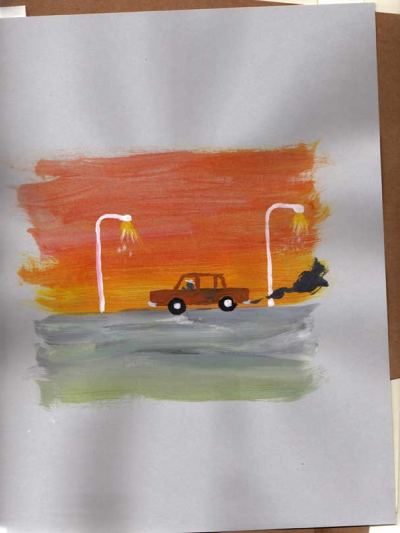
Dear Friends:
Seattle is a wonderful place in the springtime. The grass grows thick and technicolor green and flowers and trees burst with vibrant color. Rhododendrons unveil purples and pinks, yellows and red, daffodils and magnolias and cherry trees line the streets like pom poms. Spring is in full swing and boy is it a colorful affair.
Lundgren Monuments enjoys this parade of color. So much so that their monuments often sparkle with the same dazzling colors of nature. Think of how the cemetery landscape could change with glowing swatches of color sprinkled upon it's landscape. Think of how a burst of color can remind us of the magic in life, the sheer refusal to exist in shades of grey.
We wanted to share two new projects from Lundgren Monuments. The first is a bright pink arched top memorial. We set it up this afternoon and couldn't help but smile as we walked around it. It looked like a giant piece of candy, a tall glass of lemonade, an electrified flower pedal. Strangers passed by to get a closer look. "Is that a..." Well, yes it is.
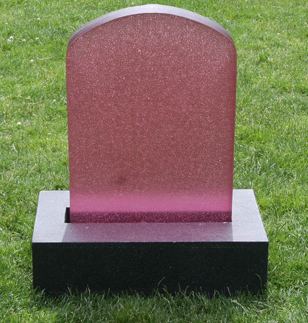
The second is a family memorial we installed this morning in Floral Hills Cemetery in Lynnwood, Washington. This rising moon/setting sun theme consists of a solid block of Butterfly Blue granite, capturing a 300 pound, four inch thick cast glass disc. The sun/moon element will change color and luminosity morning to evening and season to season.(Click to enlarge)
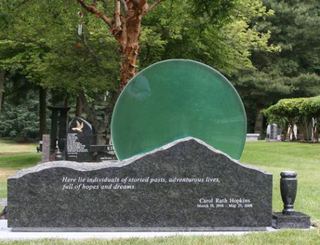
We hope you are enjoying the spring season and that sunlight and color brighten your day. Sincerely, Greg Lundgren.
Lundgren. head of arbitrary art foundation (Vital 5) here.
Lundgren, bar owner (The Hideout) here and here.
Lundgren, performance artist (member of PDL) here, here and here.
Lundgren, leader in boutique death movement here.
I.D.: Individual Demographics at Seattle's Greg Kucera Gallery is about self, an identity that's imagined, implied, cataloged, remembered or projected outward like a fog machine.
For Anne Appleby, color carries the world. In Faded Sweet Pea (oil/wax on four panels, each 16 inches square, 2008) there is a homage to the dying in the layered mutations of her shadings, impossible to see reproduced.
Nola Avienne is not interested in elegies. As she notes in her artist statement, some collectors buy art because they want to invest in a brand, which presumably has a good chance of rising in value.
If the artist has become a commodity why not circumvent the art altogether and literally own a piece of the artist?
Step right up, folks. Her Donor Wall Project features small blood portraits of 72 artists. Framed in white and hung in a grid, these expressive abstractions range from light-struck to the darkly clotted.
I love Alice Wheeler's large color print titled, Kathleen Hanna at Home, Olympia, 1993. Light makes a halo around her red henna hair, and the look on her beautiful young face is pensive. On her chest, however, she scribbled the word, "incest," followed by a question mark.
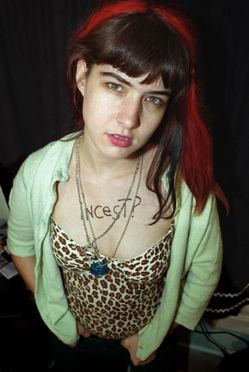 Wheeler's subjects confront the dark but stay jaunty. There's an
up-and-at-'em vibe to her work that constitutes a world view. Neither
rain nor sleet nor snow nor incest can keep a good girl down.
Wheeler's subjects confront the dark but stay jaunty. There's an
up-and-at-'em vibe to her work that constitutes a world view. Neither
rain nor sleet nor snow nor incest can keep a good girl down.
Matt Browning investigates the rituals of his skate-boarding, pot-smoking, beer-chugging and male-bonded suburban youth. Leave No Trace is a small wooden box he carved for a secret stash. The original must have been strictly utilitarian, but its recreation carries the ethos of the moment lightly, when he and his buddies huddled around a ritualized object, seeking a (collective) high.
Browning's work proceeds from the most basic questions: Who am I and where did I come from? His story is common, but his delivery is rare.
In the horizontal green yellow and red colors of the Ethiopian flag, Jack Daws created a welcome mat. Set in black lettering across the front is a qualification on the invitation: INTEGRATORS WELCOME.
 Who's on the out looking in? All the hetros who hang with heteros only, and the reverse. Also not welcome are men who don't want women at the party, the young who shun the old, the white who know no others, the rich who would not hobnob with the poor, the fleet-foot who look down on the lame.
Who's on the out looking in? All the hetros who hang with heteros only, and the reverse. Also not welcome are men who don't want women at the party, the young who shun the old, the white who know no others, the rich who would not hobnob with the poor, the fleet-foot who look down on the lame.
What about those who count as friends no one covered in feathers, scales or fur? No one who swims, flies or runs on four legs?
Scratch out their names. That's pretty much everybody. A welcome to all becomes welcome to the few who live on the wild side of inclusion. Thus, a door mat is a rallying cry to expanded consciousness, and what's flat on the floor aspires to higher ground.
Leigh Bowery was the king/queen of the London club scene in the early 1990s.
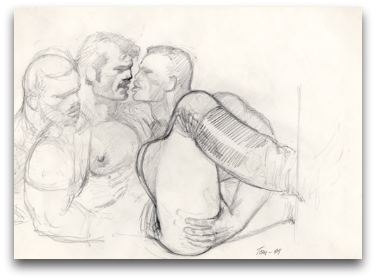 In the gap between the artist's
idealized fixations and the reality of flesh, the audience for Tom of Finland's
drawings live. The drawings arrest time, which ticks onward. They are a
time out that never ends, all coming and no going, all light and no
dark.
In the gap between the artist's
idealized fixations and the reality of flesh, the audience for Tom of Finland's
drawings live. The drawings arrest time, which ticks onward. They are a
time out that never ends, all coming and no going, all light and no
dark. Some who disdain his work are homophobic, but there are other reasons for giving it a pass. The artist created a heavenly world, a place where, in Wallace Steven's phrase, ripe fruit never fall. If there were such a thing as a wave forever hanging at its crest, surfers would shun it.
Heaven is where the imagination goes to die. Even in the literature of the faithful, hell is where the action is, which is why scholars say Milton was of the devil's party. What do mine eyes with grief behold? asks Lucifer, Milton's fallen angel. It's easy to love Dante's Inferno while failing to finish (or start) his Paradiso.
Tom of Finland refused to acknowledge that joy must end. Aesthetically, he is saved from irrelevance by the elegance of line. If painters of perfect flowers are minor, then he is minor. His interest in youth never faded in the eternal sunshine of his mind.
Set in the political context of his time, however, the artist who died in 1991 at age 71 is a hero. To delineate a version of the beautiful which mainstream culture rejects is a brave act. Just as a single man in 1989 stood up to the tanks in Tiananmen Square, Tom of Finland stood up to hatred by articulating its opposite. His art is the flower that anti-war protesters in the late '60s placed in the business end of National Guard rifles. Make love, not war.
A suite of his drawings is on view at the Greg Kucera Gallery as part of a group exhibit titled, I.D.: Individual Demographics. (More on ID soon.)
Wednesday night at 7 at the gallery, Blowing Up Demographics, a discussion moderated by Mary Ann Peters, features playwright Ki Gottberg, and artists John Feodorov and Margot Quan Knight.
Ode to Joy (European Anthem),1997 (Via NYT)
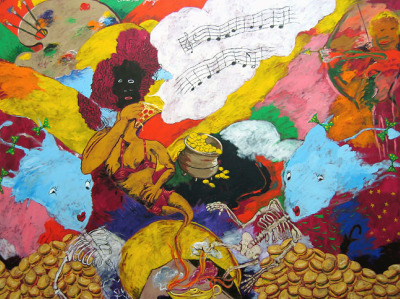 As a young painter, he lived in Seattle and found it comfortable but provincial:
As a young painter, he lived in Seattle and found it comfortable but provincial:Influences came in slowly but didn't mature and go back out again.
He had just graduated with an MFA from UC Berkeley and had spent a year in Paris studying with Fernand Leger. Married, Colescott had a young child and another on the way.
While white graduate students at the time easily secured employment at colleges and universities, nothing turned up for him.
I was in a sense more qualified than my peers. None of them had studied with Leger. Why wasn't I hired? There's the obvious reason, but I wouldn't want to guess.
After coming up empty on the college level, he papered the country's high schools and junior highs with teaching applications. A junior high in West Seattle finally called. Eventually, he taught there and in a junior high on Queen Anne.
I was a mail-order bride, shipped to Seattle.Although he felt isolated and could never get used to the damp weather, he made a number of important friendships here, especially with the late painter William Ivey.
I hate to talk about him in the past tense. Bill and I sat up nights thrashing out issues of representation. He may well have been as much of an influence on me as anybody.When Colescott left, it was to teach at Portland State University in Oregon for nine years.
He was probably happiest in Arizona on his own five acres of desert, the proud father of five children.
I hope when they think about me, they think about what I've been able to do against certain kinds of odds.
For most of his career, being black in the art world was like riding a bicycle in a swimming pool. No matter how good the swimmer, it's tough doing laps on a bike. When the issue came up at all, curators, dealers, collectors and critics could be counted on to affirm their high-minded commitment to quality in art, regardless of the race or sex of the maker.
And yet in overwhelming numbers, the artists in the forefront continued to be white males. White females came next and people of color far in the rear. Even though white is no longer always right in art circles, Colescott made his reputation before that change. What's more, he achieved a position in New York during a time when being from the West Coast was almost as bad as being black.
I had the idea of the moment. I worked it out in Seattle and it took me places.That idea was straightforward.
Their past gave them their moniker.
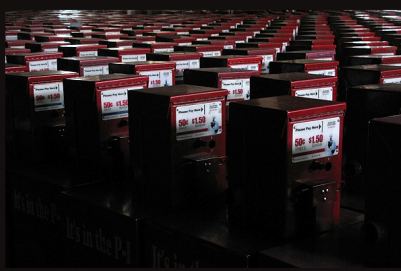
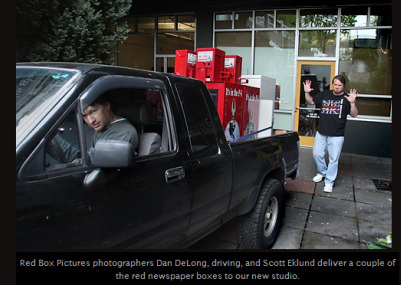
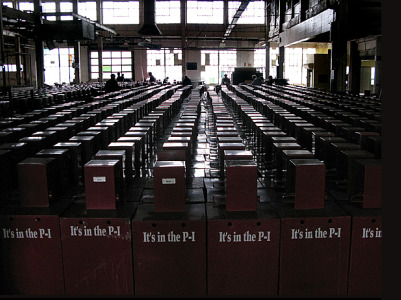
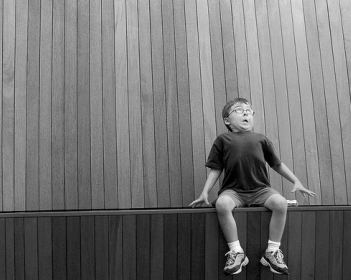 James Turrell likes to describe his grandmother telling him that the point of silence for Quakers was to "go inside and greet the light." Nobody in Dale Chihuly's childhood asked him to greet the light. With his brother and father dead by the time he was in his mid-teens, his mom had a bar she frequented whose exterior bled neon colors in the night rain. He remembers being happy she was having a good time.
James Turrell likes to describe his grandmother telling him that the point of silence for Quakers was to "go inside and greet the light." Nobody in Dale Chihuly's childhood asked him to greet the light. With his brother and father dead by the time he was in his mid-teens, his mom had a bar she frequented whose exterior bled neon colors in the night rain. He remembers being happy she was having a good time.I once asked Henry senior curator Elizabeth Brown what she thought of a comparison between Turrell and Chilhuly. She told me she thought nothing about it, because they "have nothing in common."
Nothing? Nothing but the bottom line. They both deal with colored light.
Turrell comes out of Southern California's minimalist movement and Chihuly out of decorative arts, a field that modernism rejected and Chihuly helped bring into the postmodern mainstream.
Nobody mistakes Chihuly's work for a church, unless it's the church of whoopee. He gives shape to excess and makes it shine. Turrell dematerializes the object, and Chihuly makes a fetish of its production. Next to Turrell's aesthetic virtue, Chihuly's vulgarity is startling, but at his best, he has his own kind of virtue.
On the black surface of a glass pond (Milli Fiori) flowers bloom. There are water reeds, swamp grass, irises and lilies; water snakes and coconuts, heavy orbs with bright shining wings.
Chihuly celebrates the physical, and Turrell the mental. If Chihuly's work were a fictional character, it would be Falstaff. Turrell is Prospero.
When Prospero says, "Our revels are now ended," he's relieved. Revels are not his thing. Asking Falstaff to tone it down is like like asking Beyonce to join a convent.
Audiences for Turrell and Chihuly diverge. They are each other's road not taken. What if these audiences woke one day transported to where they never wanted to be, on Turrell's high or Chihuly's low? Would they afterward see the world with new eyes or be freshly confirmed in what they felt all along?
Many years later, as he faced the firing squad, General Aureliano Buendia was to remember that distant afternoon when his father took him to discover ice.Ice thread, previous posts, enter here.
- One Hundred Years of Solitude
Latest: Charles Kitchings of Ambach & Rice adds the essential Francis Alys and Francis Alys again.
Thanks, Charlie!
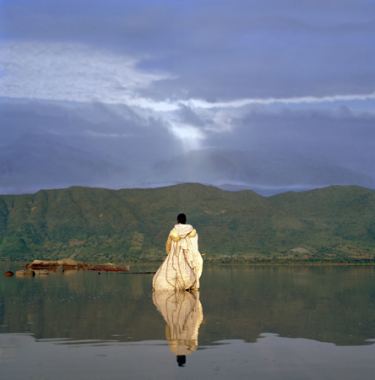 A lot of Mattingly's images look like photo shoots for a fashion magazine, which is not the insult it used to be. Art worms its way into contexts that were once excluded, partly because they were once excluded. Plus, within the glamorously provocative, Mattingly has that extra element, a subtle and toned-down version of Matthew Barney. She goes for the myth but leaves pomp and circumstance to others.
A lot of Mattingly's images look like photo shoots for a fashion magazine, which is not the insult it used to be. Art worms its way into contexts that were once excluded, partly because they were once excluded. Plus, within the glamorously provocative, Mattingly has that extra element, a subtle and toned-down version of Matthew Barney. She goes for the myth but leaves pomp and circumstance to others.(Mattingly is a key contributor to the Waterpod Project, which opens Saturday in New York City. (More info from Artforum and the New York Times.)
Ford Gilbreath has no relationship to the world of runway glamor. In spite of the pellucid clarity of his photographs, he's happy to work in the mud and is best known for hand-painted gelatin silver prints shot on the Duwamish in Seattle, a river long abused by heavy industry. It has the distinction of having one of the lowest oxygen counts in the country.
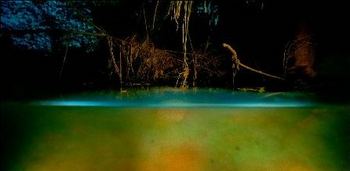 Gilbreath slogged through the river's heavy-metal murk in chest-high waders, pushing his camera in front of him in a half-submerged aquarium. With flashes attached above and below the waterline to his Hasselblad camera, he produced a simultaneous look at two worlds: air and water divided by a fluid seam or horizon line. He added density to the stark, flattened effect achieved by the camera by painting the prints in layers with transparent oils.
Gilbreath slogged through the river's heavy-metal murk in chest-high waders, pushing his camera in front of him in a half-submerged aquarium. With flashes attached above and below the waterline to his Hasselblad camera, he produced a simultaneous look at two worlds: air and water divided by a fluid seam or horizon line. He added density to the stark, flattened effect achieved by the camera by painting the prints in layers with transparent oils.
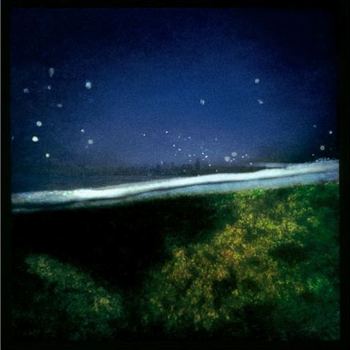 In his stagnant shallows, scum shines and greenish-brown depths
glow. He gives the drooping clumps of dead grass that hang over unnameable, watery masses scale and force beyond their size and importance. They are monuments in ruins, as graceful in their dying fall as the ruins of Greece and Rome.
In his stagnant shallows, scum shines and greenish-brown depths
glow. He gives the drooping clumps of dead grass that hang over unnameable, watery masses scale and force beyond their size and importance. They are monuments in ruins, as graceful in their dying fall as the ruins of Greece and Rome.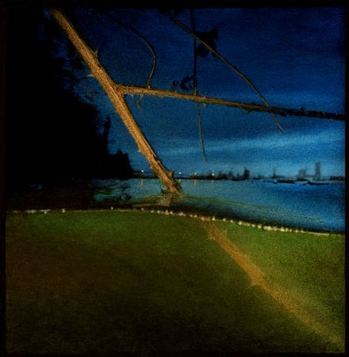 Gilbreath on the moon here. His stereoscope images in the woods (here) are the only ones I've seen that don't immediately ring the William Kentridge bell.
Gilbreath on the moon here. His stereoscope images in the woods (here) are the only ones I've seen that don't immediately ring the William Kentridge bell.Below, the best political cartoonist in the country responds to my post titled, Dave Horsey derides his former (fired) PI colleagues, here. (Well played, Dave. Match set. Your favor.)
Germaine Greer: The doctor is not in, but I feel confident in saying this woman is crazy. She used to be deranged about sex, and now she's nuts on art. She's also a pleasure. Here she is on why nuclear cooling towers are more compelling as art than art, and better than nature. (Trees? She's sick of them.)
If she were talking about Vanessa Renwick's images of a cooling tower near her home town, Greer would have a point. More Renwick on her Web site: Oregon Department of Kick Ass. As many times as I've typed that title, I never grow tired of typing it again. To paraphrase what Mark Anthony said of Cleopatra, age cannot wither the Oregon Department of Kick Ass nor custom stain its infinite variety.
 A realer reality: Blake Gopnik in the Washington Post, here.
A realer reality: Blake Gopnik in the Washington Post, here.The real always has been important territory for artists. The difference now is that while most of the more arty, "imaginative" options are looking tired, the "new realism," if we dare call it that, seems to be gaining ground. It's as likely to tweak and distort the world as to record it faithfully. It digs more deeply than ever before into what reality, and its documentation, can mean to us.More arty options look tired? Which options are those? Such generalizations, so attractive to critics, betray an inability to be specific. Art's specifics eat holes in the blanket of the general, and weaselly words such as "most" and "seems" cannot provide a patch.
Still, Gopnik's essay offers a good list of artists backed by his adequate descriptions of their work. Too bad there are no links or images. Presumably, the senior art critic at the WP doesn't have time to make what he writes minimally useful online. It's another example of mainstream media committing suicide.
Unlike Bunting and Simi, Steve Davis is not on the outside looking in. He's behind bars with his teenage subjects, serving as teacher, friend and chronicler of their experience.
Sometimes, even Davis can't get all the way in, and an institutionally-enforced failure to communicate is the subject.
Related: Chan Chao - portraits of women in a Peruvian prison, here. They're not nearly as good, but they're getting all the bounce. Reason? There's work to do, so that the Northwest's marginalized geography is not a marginalized destiny for its artists.
Below, Davis' Intensive Management Unit, Green Hill, 2000 . Click to enlarge.

More candidates? If so, email me and I'll post them here. Or, you can skip a blog post and go directly to Artist Trust to make your admiration official, giving your candidate a chance. Time to take that extra step for those who've labored long in the field. (Go here.)
elcomancho suggests Merrily Tompkins: (No Web site. Below, Big Tesla with grass growing out of its head. More on the link. Since then, she has made jewelry, example below.)
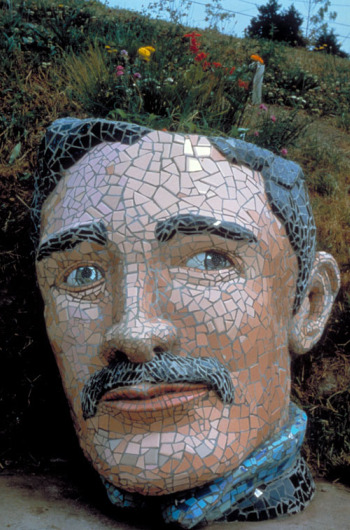
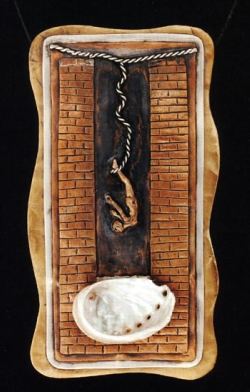 Mike Derry suggests Gillian Theobald:
Mike Derry suggests Gillian Theobald: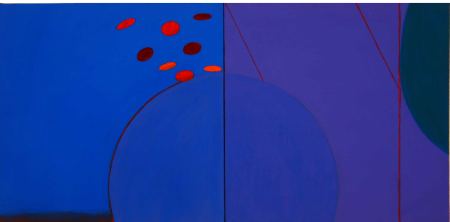
Schwitters, Merz Picture 32A (Cherry Picture). 1921
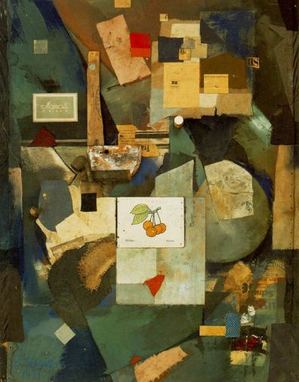 Today he's philosopher king. Early 21st century art has a strong interest not only in recycling ideas and materials, but in trying and failing to recycle them, leaving them in tatters.
Today he's philosopher king. Early 21st century art has a strong interest not only in recycling ideas and materials, but in trying and failing to recycle them, leaving them in tatters. There is a singer everyone has heard,
Loud, a mid-summer and a mid-wood bird,
Who makes the solid tree trunks sound again.
He says that leaves are old and that for flowers
Mid-summer is to spring as one to ten.
He says the early petal-fall is past
When pear and cherry bloom went down in showers
On sunny days a moment overcast;
And comes that other fall we name the fall.
He says the highway dust is over all.
The bird would cease and be as other birds
But that he knows in singing not to sing.
The question that he frames in all but words
Is what to make of a diminished thing.
- Robert Frost, The Oven Bird
That bit of ordinary magic is common. It's the story that she tells without any suggestion of a narrative, not of the glut of consumer society's casual discards but wreckage after a fall.
Stagger out into the light after losing everything and there are her sculptures on the floor, the flayed skin of soccer balls hung up on a wire or deflated inner tubes curled as if smoked in a fire.
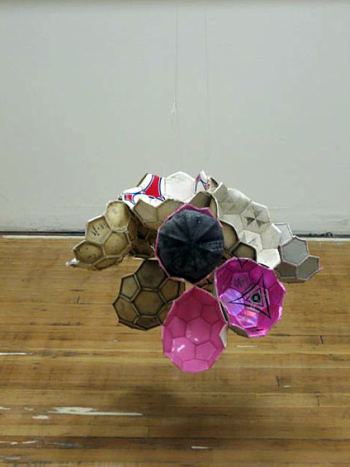
She stops the cynical and seen-it-all dead in their tracks. Next to her, Anselm Kiefer seems a bit bombastic (and I love Anselm Kiefer). While his work rages, hers is absolutely quiet.
In 1957, a young Paul Taylor aspired to her kind of silence. To that end, he and his partner stood motionless on a stage for 4 minutes, in a piece called "Duet." (The New York Times famously reviewed it with four inches of blank space.) The piece was thought ridiculous, even in time by Taylor.
What no one has done in dance, Hinrichs does with objects that become a kind of dance. They are motionless but move on.
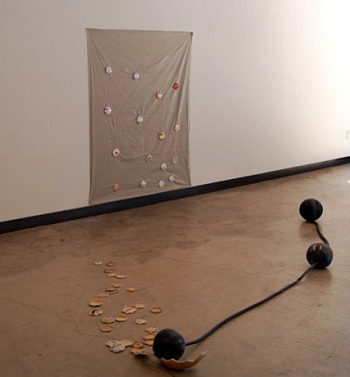
This Saturday at noon, Hinrichs talks about her work at Howard House.
Paul Kos, The Sound Of Ice Melting, 1970. (Thanks to Scott Lawrimore.) Click to enlarge.
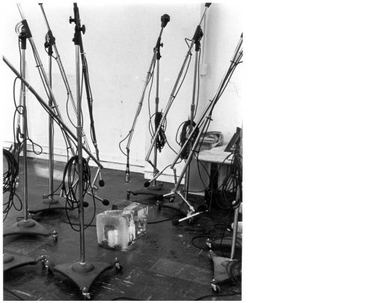
Now that frat boys think nothing of covering their forearms in morning glories, however, tattoos don't necessarily have the edge they once did, which makes the Northwest Film Center's contributions vital.
On June 21, the center will screen A Scarred History of Great Britain; July 25, Hori Smoku Sailor Jerry, and Aug. 20 The Mark of Cain, tattoos from the Russian Gulag.
About Sailor Jerry. Not a lovable old salt. Here's his list of 7 Reasons Not To Get A Tattoo, via Cookie, which hung in Jerry's parlor. We can quibble over which is most offensive. (I'm going with #3. ) But for taking a trip down memory lane with a pure product of old-time, outcast America, his movie can't be beat.
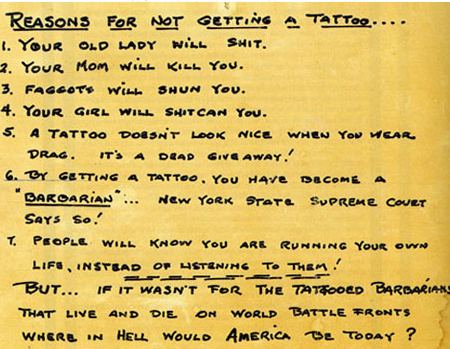 A few years ago in New York, riding the bus back downtown from the Studio Museum Harlem, I found myself sharing a seat with a lean wolf of a white guy.
A few years ago in New York, riding the bus back downtown from the Studio Museum Harlem, I found myself sharing a seat with a lean wolf of a white guy. Three permanent tears ran down his face, which I believe could have alluded to an unfortunate encounter in prison. His white shirt rolled up with a package of cigarettes in a sleeve revealed a text: Born to Lose.The song hung in my mind and surfaced a couple of blocks later. Yes, I broke into unconscious song.
Suffice to say he was not amused. I was happy he didn't belt me, as the don't-hit-a-woman rule seldom applies in his circles. Later that night, tucked up in bed, I realized that the oddest person on the bus that day had a press pass.
To win, you have to be female. (See Jerry Saltz for how well that's working out, after 40 years of second-wave feminism. Here followed by here.)
You have to live in Washington State, that hotbed of visual art careerism.
You have to be 60 or older. (Old artists = forget about it.)
Yvonne Twining Humber was overlooked most of her life and distracted by the tasks that pull women away from being artists.
(Image: River Picnic, 1940. Click to enlarge.)
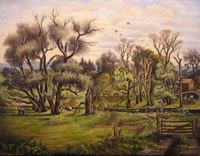 Yet she kept on. Relatively famous in Boston in her youth, she moved to the Northwest with her husband and promptly fell off the art map.
With the proceeds from the sale of her house, she set up this award as a shout out to other women in Washington state who find life getting in the way of art.
Yet she kept on. Relatively famous in Boston in her youth, she moved to the Northwest with her husband and promptly fell off the art map.
With the proceeds from the sale of her house, she set up this award as a shout out to other women in Washington state who find life getting in the way of art. It was her way of saying, "You're not alone; keep going." Humber puts me in mind of Tillie Olson, whose stories of women buried alive under homemaking reflected her own life and meager art output.
A number of recomendations, although the output of none could be called meager. (NOTE: I deleted a few names from the original post for the excellent reason that the artists who answer to them are not yet 60.)
Sherry Markovitz
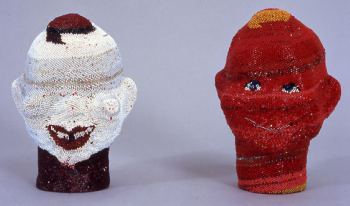
Gene Gentry McMahon
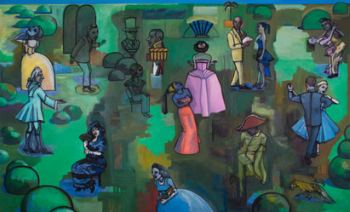 Susan Skilling:
Susan Skilling: 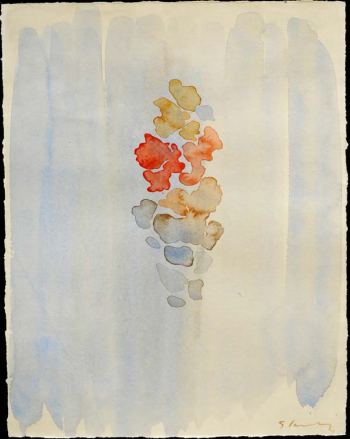 Heidi Oberheide:
Heidi Oberheide: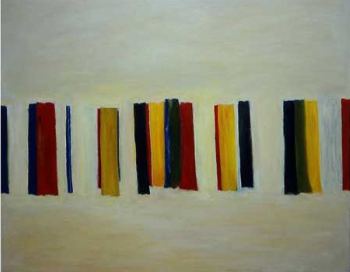 Gayle Bard:
Gayle Bard: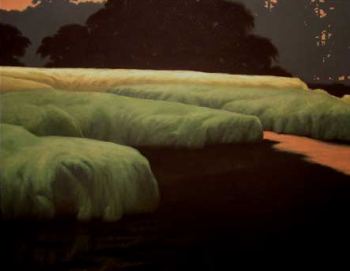
Barbara Noah:
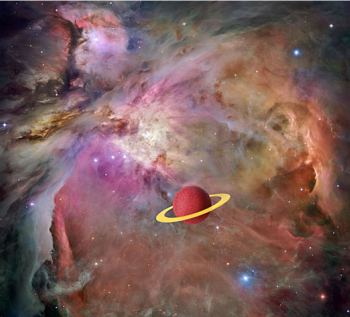
At a party for the new PI, Horsey welcomed the assembled "to the revolution."
It's no secret that the media world is being turned upside-down, and as in any revolution there is some pain and discomfort in all the changes. But there are also incredible opportunities. Something new is being born, and I think we're giving birth to it right here.He was referring to the online-only PI. How can a shadow of the old be a model for the new?
Unlike more than 80 percent of his former colleagues (including me), Horsey wasn't shown the door. And unlike the few who remain (except freelance), he did not have to give up his severance to remain employed (like Eric Nalder, directly by the Hearst Corporation). Nor did Horsey have to accept a big pay cut or lose other benefits.
Makes sense that he was favored. Hearst would be crazy to let him go, as he is the best editorial cartoonist working in what used to be called mainstream media. On the other hand, did he have to go that far in praising the ghost of a newspaper? Something new is being born with a shallow, once-over-lightly approach? Not only new, but revolutionary?
Thank God Hearst got rid of the dead weight, right, Dave? The people who insisted on asking pesky questions. Who needs them? The new PI can rewrite a press release and post that puppy before it has time to pee on the carpet.
On Wednesday Horsey aimed another kick at the departed.
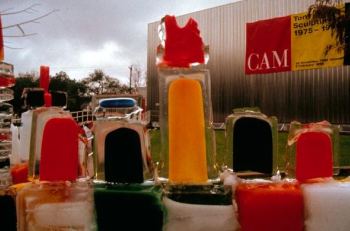
Dale Chihuly fills his with neon.
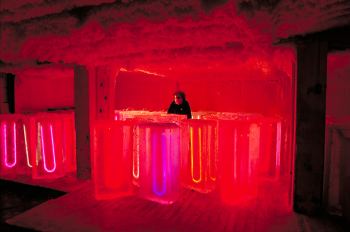
Tavares Strachan doesn't want his to melt (death arrested).
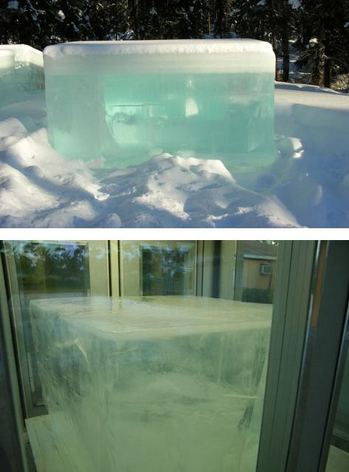 Neither does Marc Quinn, who made his from his own blood.
Neither does Marc Quinn, who made his from his own blood.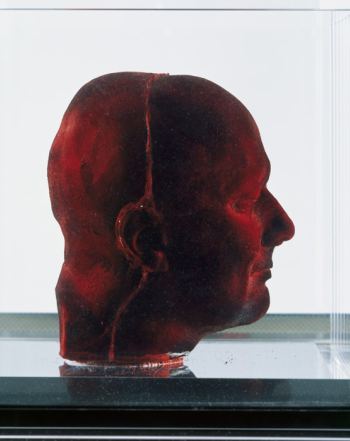 That leaves Jeppe Hein, whose work currently assays the puddle state in the center of the main gallery at Western Bridge, as part of its new exhibit titled Underwater.
That leaves Jeppe Hein, whose work currently assays the puddle state in the center of the main gallery at Western Bridge, as part of its new exhibit titled Underwater.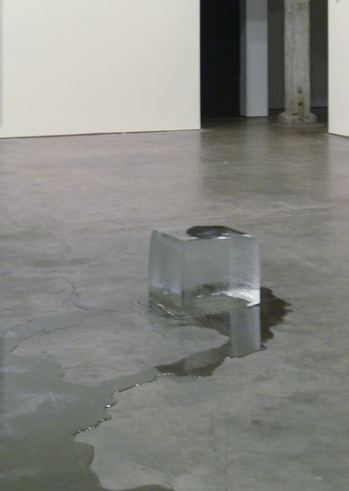 In every way I prefer the Hein, for its modesty, rigor and purity. Next to it, the others seem to have dressed for a costume party nobody was holding. Truth to materials is an old-fashioned idea. When it works, it can still knock the competition off the board.
In every way I prefer the Hein, for its modesty, rigor and purity. Next to it, the others seem to have dressed for a costume party nobody was holding. Truth to materials is an old-fashioned idea. When it works, it can still knock the competition off the board.(Baxter's current show here. My review here.)
In the interests of getting me to leave her alone, however, she sent me a few images from her old world, created late in the 1990s into the mid-2000s.
The first I saw were made of powder puffs sewn together. They loomed with lumpy grace out from the wall, obviously clouds and something else too, carriers of an antique feminine code - the gangster's moll who powders her nose as men plot murder.
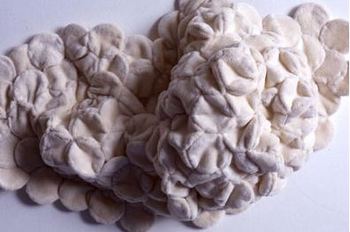 Powder puffs beautify their owners while being themselves quickly
stained and discarded, just as despoilers of the land, made rich, move
on.
Powder puffs beautify their owners while being themselves quickly
stained and discarded, just as despoilers of the land, made rich, move
on.
Quickly following were another series of larger, more imposing powder-puff clouds, caught in the act of transforming themselves into something more substantial, maybe the white cliffs of Dover. When they mutated again, they had taken on an ominous cast, spreading along a ceiling and down the seam of a wall like a fungus, a powdery decay.
At the end, she was back to beauty in a big way. A single cloud hung from floor to ceiling in the Platform Gallery. Made of silk tissue paper, it billowed with a dainty grace in spite of its bulk.
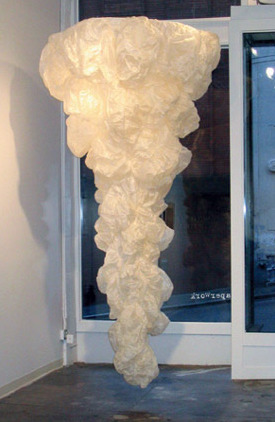 An exhibit
at Gallery 4Culture titled, The Cloud That Fell to Earth, was a tribute to Walter Tevis' 1960s novel about a man who fell to Earth, too alien, tender and talented to thrive here.
An exhibit
at Gallery 4Culture titled, The Cloud That Fell to Earth, was a tribute to Walter Tevis' 1960s novel about a man who fell to Earth, too alien, tender and talented to thrive here.
The massive cloud made of cotton and felt clung to the ceiling as if it feared falling. Wrapping itself around the gallery's industrial air ducts, its intensity was spineless. This pendulous portent, this baggy monster, wanted to retreat and had nowhere to go.
In Spent, her cloud is a loogie hawked out of the sky to land with a muffling thud on a pine tree. In the photo that pretends to document sky's insult to land, the pine tops a mountain, with white air surrounding the tree as a kind of reverberation.
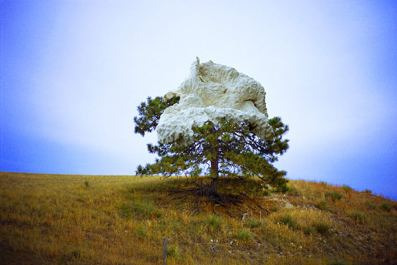 In a series of small photos collectively
titled Portable Weather System, a cloud tries its luck in a
variety of settings and yet remains a stranger. It's
strange on a lonely road, strange at the ocean and strange indoors.
Apparently, loony clouds can lose their place in the natural order.
In a series of small photos collectively
titled Portable Weather System, a cloud tries its luck in a
variety of settings and yet remains a stranger. It's
strange on a lonely road, strange at the ocean and strange indoors.
Apparently, loony clouds can lose their place in the natural order.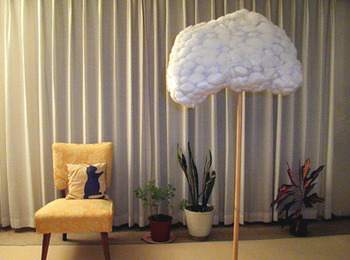 Me and My Cloud portrays Baxter as a nurse taking her
ailing air mass for a walk.
Me and My Cloud portrays Baxter as a nurse taking her
ailing air mass for a walk. 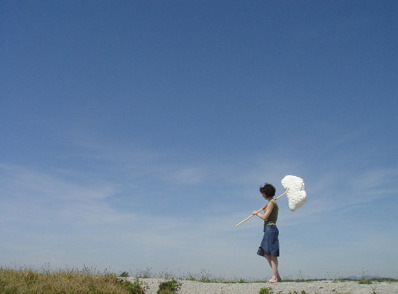
Art consists in going the full length. If you start with drums you have to end with dynamite, or TNT.
- Ravel, quoted in Henry Miller's Tropic of Cancer.
Debra Baxter began with clouds. She tracked the drift of distant fairy palaces even as they fell splat onto a tree, like a gob of spit hawked from the throat of a hostile sky.
If the sky was going to spit on her, she might as well return to her studio, which she did, ending career as a landscape artist.
The objects she makes now bear a direct relationship to her body. (At Howard House through June 24.)
Suck it Up (carved alabaster and quartz crystal) 2009
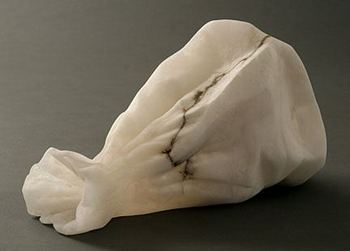
Jeff Koons began in similar territory in 1985, with Aqualung.
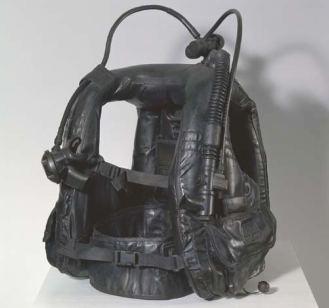 His is a generalized emblem of failure. Hers is intimate. One need not be in trouble to put on a life vest, but to blow into a paper bag requires a panic attack.
His is a generalized emblem of failure. Hers is intimate. One need not be in trouble to put on a life vest, but to blow into a paper bag requires a panic attack.Baxter's sculptures are the dead end of romance. If jukeboxes played visual art, Baxter could turn Jerry Lee Lewis inside out: You broke my will, what a thrill.
You Turn Me Inside Out Like a Glove. carved alabaster, 2008
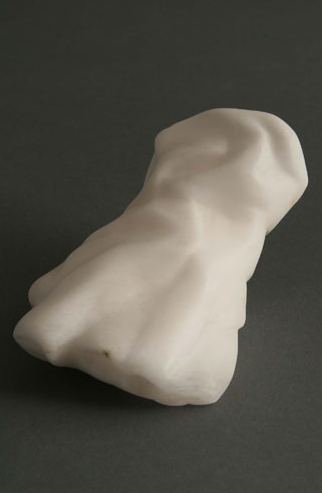 The lavish praise parents heap on their grown children cuts the heart, as it betrays an anxiety the child might otherwise not know the parent feels for her future.
The lavish praise parents heap on their grown children cuts the heart, as it betrays an anxiety the child might otherwise not know the parent feels for her future.So Proud of You, 2007
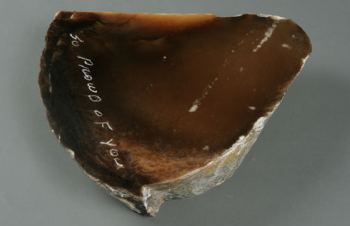 The partner who asks for a time out has all the power.
The partner who asks for a time out has all the power. Time Out. Glass, sand, sterling silver, African wonder stone, 2009
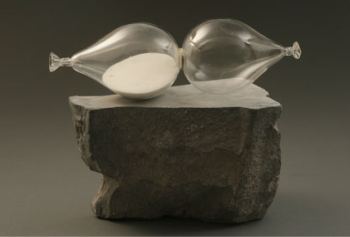 You can say anything to a loved one. The open channel of heart-to-heart communication seals the deal. Right? What could go wrong?
You can say anything to a loved one. The open channel of heart-to-heart communication seals the deal. Right? What could go wrong?Speed Bag (Love Tap) 2007
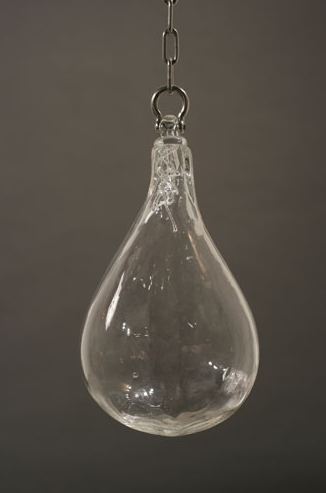 The artist paring down for purity might, depending on her materials, release slivers that burrow into her lungs, making the process of making art a fatal attraction.
The artist paring down for purity might, depending on her materials, release slivers that burrow into her lungs, making the process of making art a fatal attraction.Dust Mask (Catching My Breath) alabaster, sterling silver 2009
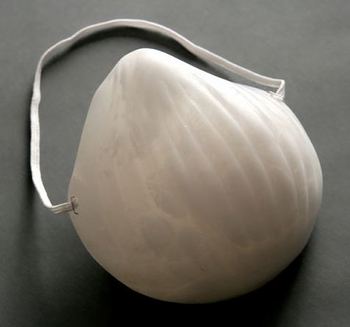
There is nothing wrong with this exhibit save for the exhibit itself. Heidi Hinrichs, the great master of the material forlorn, is in the front gallery, Baxter in the back. To counter the spell Hinrichs casts, the second artist has to engage the work by batting the ball back or be so completely different than comparisions don't occur.
Baxter can't take either route, and she isn't helped by the long brown ugly table on which her sculptures appear, as it makes her work look puny. Outside the context of the Howard House show, however, she's golden.
Little lamb if you are able
Turn yourself into a table
- fragment from Irish fairy tale
Here's three that deserve more play.
Jesse Durost
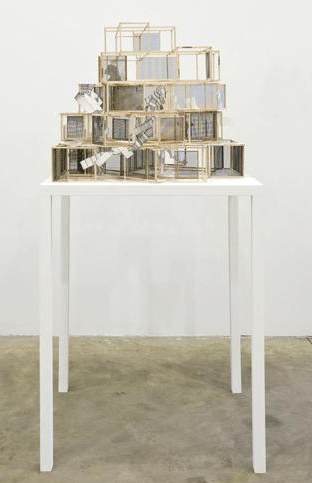 Andrew Keating:
Andrew Keating: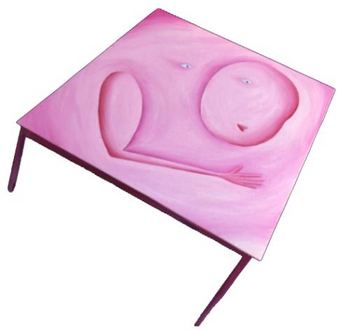
Saya Moriyasu

Andreas Bee considers the meaning of shelter at Suyama Space. (Beth Sellars curator. Through Aug. 14)
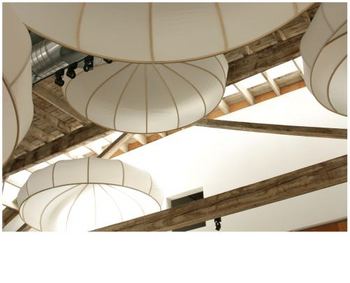 His floating sculptures on thin, bendable wooden-strip supports resemble hats, umbrellas, clouds or pup tents. They are shelters deprived of function, as there is no sky in a gallery and no need for protection against the elements.
His floating sculptures on thin, bendable wooden-strip supports resemble hats, umbrellas, clouds or pup tents. They are shelters deprived of function, as there is no sky in a gallery and no need for protection against the elements.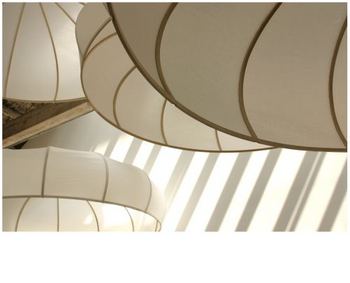 They are intrusions that slid into space with the grace of a ballet dancer pretending to be a butler. The audience is free to wander where it wants, but everywhere it goes, it is in relation to the structures hanging high or low throughout the expanse. When people stand under one, they perceive themselves wearing light like a shawl. Those on the outside see those inside as torsos with stylized cloud heads. At the opening, it was hard to keep talking. Instead, attention gravitated toward Bee's wordless thought bubbles, how they slowly swayed in the room's air currents, took up all the space without dominating it and served as advocates for the Herman Meville school of art, promulgated in 1851 in Moby Dick:
They are intrusions that slid into space with the grace of a ballet dancer pretending to be a butler. The audience is free to wander where it wants, but everywhere it goes, it is in relation to the structures hanging high or low throughout the expanse. When people stand under one, they perceive themselves wearing light like a shawl. Those on the outside see those inside as torsos with stylized cloud heads. At the opening, it was hard to keep talking. Instead, attention gravitated toward Bee's wordless thought bubbles, how they slowly swayed in the room's air currents, took up all the space without dominating it and served as advocates for the Herman Meville school of art, promulgated in 1851 in Moby Dick:Do not reflect, compare, analyze, possess, but flow in and through, endlessly, like music.
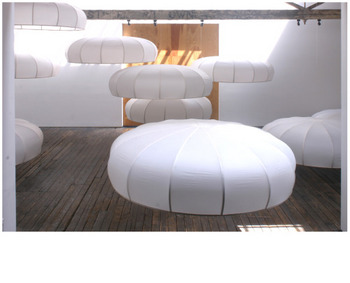 Martin Puryear is a member of the Melville School, which advocates thinking without words, through materials. In their myriad-minded manifestations, so are Robert Irwin and Cris Bruch. For starters.
Martin Puryear is a member of the Melville School, which advocates thinking without words, through materials. In their myriad-minded manifestations, so are Robert Irwin and Cris Bruch. For starters.Vital 5's Arbitrary Art Grant ($500) in the performance art category went to somebody who showed up to check it out.
From Dino Martini, gallery dealer on the scene:
Many, many people driving or walking by of course believed it was a "real" protest against performance art... In the end, a protester by the name of Garrett Hobba took the prize of $500 in $5 dollar bills. He showed up to see what the situation was and ended up winning. (Vital 5's) Greg (Lundgren) let his intern pick by using a rifles scope (minus the rifle) from across the street. Whoever she pointed at first won.Lundgren sent the images below. Only in an arbitrary world would Hobba, a musician, top these visual artists in their own game. No wonder they're protesting. No justice, no peace. Click to enlarge.

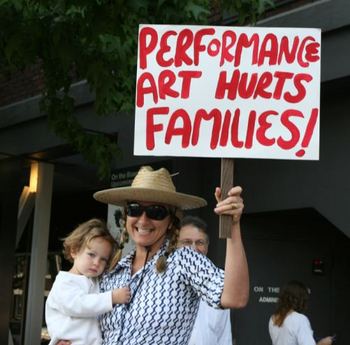
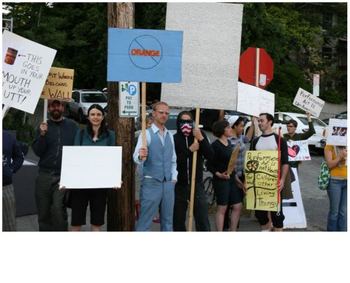 Other performance art protests that were in the end, performance art, include Kelly Mark's Demonstration in Toronto in 2003 (restaged in front of the Henry Gallery in 2006) and Anna Halprin's Blank Placard Happening from 1968, restaged in Portland, Oregon, last year. In the photo immediately above, FlatChestedMama restages Halprin and Mark, proving that something can come from nothing.
Other performance art protests that were in the end, performance art, include Kelly Mark's Demonstration in Toronto in 2003 (restaged in front of the Henry Gallery in 2006) and Anna Halprin's Blank Placard Happening from 1968, restaged in Portland, Oregon, last year. In the photo immediately above, FlatChestedMama restages Halprin and Mark, proving that something can come from nothing.Mark's Web site here. Her version of pointlessly rousing the rabble came equipped with blank slogans:
What do we want... NOTHING!!!
When do we want it... NOW!!!"
Hell No...We Don't Know.
Harvey: Jesus Christ, Regina. Your lead is dead.
Me: Don't you admire its conceptual rigor?
Harvey: Even if there were hope, which there isn't, I don't have time for CPR.
Although (and sometimes because) he could be abrasive, sarcastic, impatient and a tough sell for an art critic, I remember our time together fondly. He could find clarity in a muddle and never lost sight of the ultimate goal: to connect to a general audience without losing the interest of the already on-board.
Before Billy Howard moved his gallery (Howard House) to Pioneer Square, he was unhappily in Belltown. Howard had grown sick of the intrusions of the drug trade and asked me to write a story about it, here. The day it appeared, a member of the community he deplored approached him on the street to suggest he and his ilk were displeased by the tone of the coverage. Then the dealer in drugs punched the dealer in art in the face.
While expressing sympathy for a bruised friend, I felt a secret and shameful thrill. Drug dealers are reading art stories!
One day on the Vashon Ferry, I saw a woman pick up the PI's entertainment section and page through. She read Gene Stout (rock) and William Arnold (movies). Theater she treated with a once-over-lightly scan, and classical music she skipped entirely. Her eyes fell on my page. I waited. She read the headline, looked at the picture and passed me by. Had I been sitting closer, I might have tried to talk her into reconsidering. (Ok, the lead's slow, but you might be interested in...)
If I connected with any public outside the previously committed, I'm not aware of it, but I appreciated the decades-long, never-say-die chance to try.
Time to say die.
Art magazines and art blogs are the journalistic equivalent of studio art, while an art review in a newspaper is like public art. Anyone from any background might happen upon it.
Where I write now does not exist in a generalized public sphere. A street sweeper on coffee break will not happen upon a leftover copy of this blog and be drawn into a review. A woman getting her heels buffed won't find it on the empty seat beside her and be motivated to see an exhibit of which she might otherwise not have heard.
For an art critic, the death of newspapers is the death of potential connection to wider worlds. Everyone who reads this blog has a preexisting condition, otherwise known as an interest in art.
On the other hand, there are notable benefits. Where I'm writing now, nobody tells me what to do and nobody derides my blog just because it's a blog.
Below, the thoughts on blogs from the final three (in the final two years) PI A&E editors.
Duston Harvey (my favorite by a mile): You're wasting too much time on that blog.
Emily White: I hope you don't think I have time to read your blog.
John Levesque: I hate blogs. (Big sigh)
Last Friday, Vital 5 awarded another $500 dollars to somebody (anybody) with a sign protesting performance art in front of On The Boards, in honor of its NW New Works Festival.
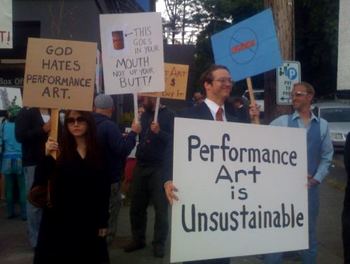 Photo, Dino Martini. Four in front, left to right: Emily Pothast (God Hates Performance Art); Steven Miller (This Goes In Your Mouth Not Up Your Butt!); Jed Dunkerley (Performance Art Is Unsustainable) and John Sutton of SuttonBeresCuller (unreadable from here).
Photo, Dino Martini. Four in front, left to right: Emily Pothast (God Hates Performance Art); Steven Miller (This Goes In Your Mouth Not Up Your Butt!); Jed Dunkerley (Performance Art Is Unsustainable) and John Sutton of SuttonBeresCuller (unreadable from here).I love Pothast's parody of her own interests. Ditto Miller, rabidly against what he cares about most (freedom). Dunkerley's business consultant is a victim of his excessive self-esteem. If I were picking from the sample, Pothast would be picking up a check. Scoring aesthetically in this psudeo-protest, however, was of no value to the outcome, which is why so many artists turned out.
Featuring two vagina-shaped crashed cars impaled on penile poles and bare-breasted paintings of super heroes, the show is the closest thing I've seen to pornography lately.That's a bad thing? First, it's her idea that the smashed cars are vaginas. I like it, but it's her metaphor. Second, although she has the advantage on me, having stood in the gallery instead of only seeing representations online, I'm pretty sure these sculptures aren't anywhere near porn.
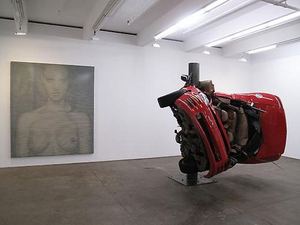 Porn is business. Ask your average male-seeks-female porn consumer if Skreber's sculptures pass the porn test. They lack porn's functionality. Like the Beatles in the late 1960s, porn loves to turn you on. Who's turned on by these? I want to see hands.
Porn is business. Ask your average male-seeks-female porn consumer if Skreber's sculptures pass the porn test. They lack porn's functionality. Like the Beatles in the late 1960s, porn loves to turn you on. Who's turned on by these? I want to see hands.Because she interprets the sculptures as vaginas wrapping a phallus, she's against them. At the risk of being an insensitive clod, I don't see why aggressive sexual imagery has to be denigrated or denigrating. The heart is a corkscrew. Art from the heart doesn't always dress for dinner or pass muster in a women's studies class. My version of feminism does not foreclose on desires (even rage-filled desires) that have no victim.
In spite of stepping off the cliff from time to time (who doesn't?), Johnson is essential. Here's an example of why.
Kenneth Baker's review of Squeak Carnwath at the Oakland Art Museum opens by acknowledging the broad general view and sympathizing with it:
It took me a long time to warm to Squeak Carnwath's painting. Twenty years ago, I regarded it as a self-involved pastiche of outsider-art mannerisms. But the Oakland Art Museum's survey of the past 15 years of Carnwath's work makes a nearly irresistible case for its authenticity and substance.I'm not persuaded, but the review is so powerful I'm left feeling that I need to see this show before continuing to indulge a long-standing dismissal. On the other hand, a good curator can hide major faults and stress minor virtues, which might be all that happened here.
Baker again, on Robert Frank:
Part of Frank's originality was to institute the photograph as a membrane responsive both to a moment's reality and the photographer's feelings about it.
Holland Cotter on the heart of the matter at the Met's African/Oceanic survey:
In the Michael C. Rockefeller Wing at the Metropolitan Museum you'll find a tiny African copper relief that probably predates, and would surely have awed, the great Lorenzo Ghiberti. You'll encounter a bust of a Nigerian beauty to rival Nefertiti; an Oceanic Apollo with the physique of an Olympian; and a Micronesian statuette that is, with its stacks of faceted planes, Brancusi before Brancusi. (Review here.)Cotter again, on Giacometti:
These portraits are laborious, noodling things, their lines repeated over and over as if Giacometti were determined to create something solid from nothing, then to obliterate that something. Far more relaxed -- and surely Giacometti drew as compulsively as he did to relieve tension -- are the drawings that look incidental, on the fly: an empty studio interior, apples in front of a window, a pot of tulips, a tree. Heaviness lifts; anxiety is dispelled. The faint lines of the tree fly outward and upward like flames, evidence of a lightened-up, fly-away artist that some part of Giacometti may always have wanted to be.From Culture Monster, Daniel Nicoletta's portraits of Harvey Milk, A life (cut short) in pictures, here.
Also from Culture Monster, David Pagel's fine review of Kelly McLane: (Yes, description still mattters.)
In "Zero Gravity Madonna Lab," plump pink babies grow like hothouse tomatoes as older kids, in hermetically sealed bubbles, evoke science experiments gone wrong. In "Flaming Arrow," a sunny sky rains cherubic cowgirls as a monstrous maw opens in the desert floor to devour everything around it.
Her paintings add depth and color to such point-blank encounters, making the grand sweep of history come alive. If her oils and acrylics on canvas were novels, they would have a lot in common with works by Mark Twain, Wallace Stegner and Thomas Pynchon.
Pagel again: His review of Pae White is a thing of beauty:
From Jen Graves, definitive piece on commercial ventures borrowing or stealing from artists, here. Facts cited and complexities illuminated.Over the last couple of decades, Pae White has made art out of almost nothing but thin air: a handful of cat whiskers affixed in a drop of glue, a spray-painted spider web set in resin and the shimmering reflections cast from a slab of mirrored Plexiglas sheets. At 130PE, the light-handed artist continues her lighthearted gambit, transforming incidental things into instances of wonder that are ripe with delight.
What's new is the delicate touch of melancholy. Smoke and leaves are the vehicles for White's casually exquisite installation, which consists of woven tapestries, laser-carved sheets of brightly colored paper and hundreds of fake leaves, all made mechanically and many painted, stained and shaped by hand.
Graves again: She offers to take note in a public artist's support group - real interviews in an imaginary frame. Funny, true and frightening, here.
From Sebastian Smee at the Boston Globe, a dud of a review of Matthew Day Jackson. Smee looks for polish and misses the power of the artist's hungry heart.
Smee is in his 30s but writes as if he's more than twice that age, cozying up to the audience as if he's entertaining it over brandies in a men's club. Even when he's writing well, which is frequently, I feel like shaking the smug out of him. Maybe that's all he needs - one good shake.
(Note to Smee: Get rid of most of your adjectives and step off your high horse. Treat your reading audience as if it's a collection of intelligent but potentially dangerous strangers you've been hired to engage. Do not speak for them, pat them on their heads or presume to anticipate their reactions, and you'll be fine.)

We're all normal and we want our freedom.
Marat/Sade
Jen Graves, from a review titled, Making Art While Nervous: Buddy Bunting's Plein Air Prisons:
Buddy Bunting stakes out prisons. He parks by the sides of their roads to sketch, photograph, and videotape them in a hurry, before he gets caught.(Her review here, with images.)
Nobody is supposed to look too closely at a prison. Bunting does it in part because prisons are what he knows. Growing up in a Maryland area where a prison moved in and provided plenty of jobs, Bunting's regular friends were prison guards as well as prisoners. He knows the in and the out, so he stands at the border and makes art.
Most of the drawings in the current show derive from the Southwest. Solid objects are dematerializing in the heat and so are ideas, such as justice and a workable economy.
(Click to enlarge.)
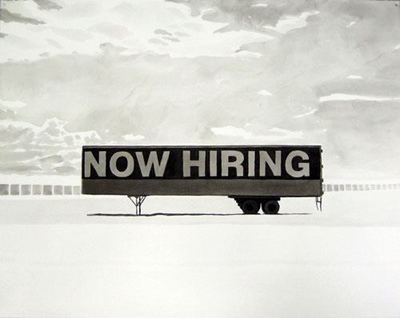 I've seen and greatly admired Bunting's work over the years. This show is the show. I must have been in a coma to have forgotten to see it till its final weekend.
I've seen and greatly admired Bunting's work over the years. This show is the show. I must have been in a coma to have forgotten to see it till its final weekend.Considering how large a role prisons play in the U.S., they rarely make an appearance in art.
Bunting's not the only artist in Seattle with a bead on them. Mike Simi was raised in a small Michigan town near near a large one. His dad, his uncle and his brother are prison guards. He happened to go to high school with nine of the 40 registered sex offenders in his area. No one in his family finds that fact remarkable.
Below, Simi's from series of throw pillows titled, Sex Offenders From My Home Town, ongoing.
(Click to enlarge.)
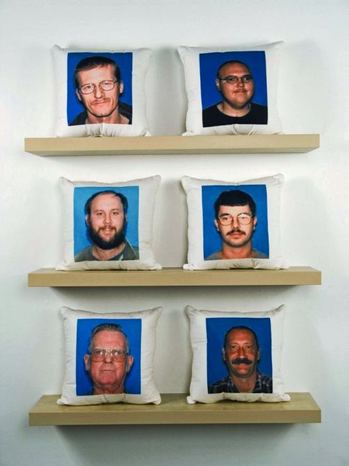
Last time I checked, a couple of months earlier, Lyons said the gallery was not in debt. In five years, it has managed to break even, although it never turned a profit. That's five years without salaries from the gallery, as the owners do not take money out for themselves.
The good news is, Lyons intends to continue. (If you are a collector who asks for discounts, think about who you're asking them from.)
The gallery's contributions to Seattle are profound. It has raised the tone, raised the ambition and made a point of connecting the local with the global.
The many exhibits I am eternally grateful to have seen include Kelly Mark's Stupid Love; Jesse Burke's Dark States; Jaq Chartier's Blind Sight; Scott Fife's I Am What I Am and True Grit; Patte Loper's Let Our Beauty Ease Your Grief and A Peculiar Brightness of the Sky; Adam Satushek's In Between Days and, of course, everything from Matt Sellars and William Powhida.
I hope this doesn't read like an obit. But Lyons is heading into the summer (always slow) with an at-best break even proposition in a terrible economy.
As for Haygood, contrary to the title of the painting below (I'm Not Really Sure It Matters from 2006), his work does and is well worth his renewed engagement.
(Click image to enlarge.)
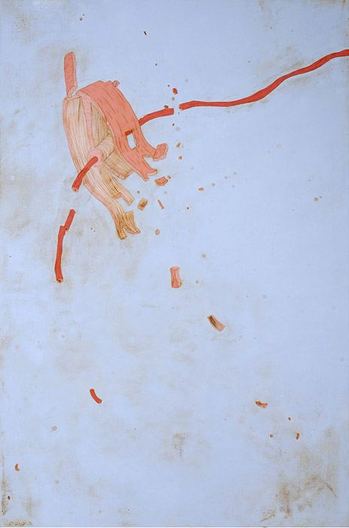
Fred Muram is moving to Chicago. Soon. Let him Kiss The Ceiling in a crack house. At least he's not going to LA.
Maybe he saw Suzi Barrett's I Hate LA. It takes the sheen off art's magic kingdom. (Stop dropping names, shadow.) Via Bad at Sports.
In 1993, after endless negotiations with the Department of Energy, Acord became the only individual on the planet licensed to ``own and possess" nuclear material. To mark his triumph, he had the license number tattooed on the back of his neck.I didn't have an image of that tattoo. Now, thanks to Arthur S. Aubry, who took the photo sent via Howard House, I do.

I remember them as exceptionally snappy dressers.
(Below, Fashion is Love, 2003)
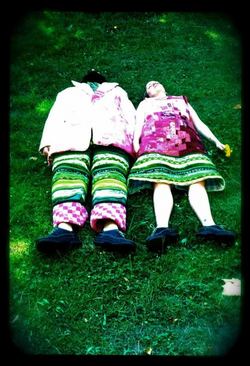 Since marriage and the birth of their son, Hazel, now four, Greer is the only one whose profile remained high.
Since marriage and the birth of their son, Hazel, now four, Greer is the only one whose profile remained high.Margolis put his career on hold to concentrate on bringing home the bacon, raising Hazel and helping his wife with her various (always fascinating) projects.
Breathes there a feminist who isn't charmed by this tale? I'm sold, with the reservation that a two-artist couple is most feminist when partners find a way for both to prosper, which is what's happening now.
Margolis is back. (His blog here.) What he makes relates to his experiences as city bus driver, dad and husband.
1. Stand-up partner. Even on a diagonal (Stud), he can be counted on.
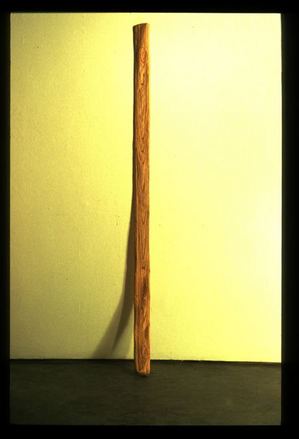 2. Dad. Below, he shows Hazel how to be a Vitruvious Man.
2. Dad. Below, he shows Hazel how to be a Vitruvious Man.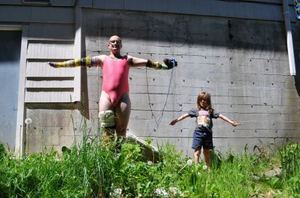
Do It Yourself. (Right Fingers) Teaching Hazel to work with his hands.
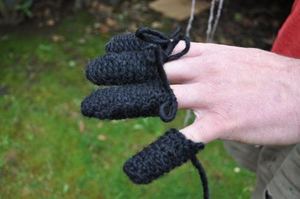 Nuturing. (Yarn Tree 5) Hazel sees that men can caretake.
Nuturing. (Yarn Tree 5) Hazel sees that men can caretake.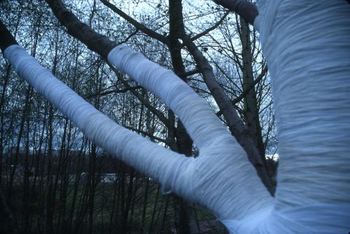 3. As a bus driver, Margolis obeys all street signs (here and here) and has the back of meter maids.
3. As a bus driver, Margolis obeys all street signs (here and here) and has the back of meter maids. I Dreamed I Was A Meter Maid is now on view in the lobby of the Bellevue Arts Museum. Margolis talks about his work tonight at the museum. (Sorry for late notice.)
I Dreamed I Was A Meter Maid is now on view in the lobby of the Bellevue Arts Museum. Margolis talks about his work tonight at the museum. (Sorry for late notice.)Speaking of his lecture, BAM's promo belongs on FAIL Blog:
Free First Friday Lecture Series: Paul Margolis: Quilting and fiber artist Paul Margolis works with unique materials such as vinyl and lace. His piece I Imagined I was a Meter Maid is featured in Bellevue Arts Museum's Forum. Join him for a lively talk about this creative and quirky work of art as well new ideas and past pieces. 6:30 - 7:30 pm FREE for members/$5 non-members.Hello BAM: Free First Friday? Even in Bellevue, $5 isn't free.
Take Secor's #6, Location, Location, Location. Last night at Heide Hinrichs and Debra Baxter's opening at Howard House (more later), I found myself talking to a woman who wants to open a gallery in Post Alley (Pike Place Market.)
"Nobody will come," I told her. "There's no place to park and nothing that amounts to any kind of art density already in place." Yes, in a better world, we'd all hoof it far and wide. Neither rain nor sleet nor hail nor snow and so forth. In this world, to misquote Bob Dylan, the dealer will die out there and be another accident statistic.
Or, as Secor put it:
6. Location, Location, Location. Think twice about the gallery you have chosen. Is it off the beaten path, perhaps in a sewage pipe or demolished building? Is it easily accessible? (For example, does it have a door, or do you have to crawl through a window?) Is it surrounded by barbed wire? Once a patron enters, is he ever heard from again? Is the gallery owner reputable or does he have a name like Louie the Lip?The dealer doesn't have to stress his lip to be unreliable. Call it the kick the dog theory. A guy has a bad day at the office, comes homes and yells at his partner. His partner yells at the kid who kick the dog who defecates in the shoe of the guy who had a bad day at the office.
In a bad economy, dealers struggling to stay afloat too frequently fail to pay artists in a timely fashion if at all, thinking as dealers they need the money to make frayed ends meet. (Isn't this the reasoning of bank robbers?)
It's the untold story. I keep hearing it, always with a don't-tell caveat. If desperate, artists might yell at the kid, but they protect the dealer till there's absolutely no reason to do so. That's why it's important to have a dealer who doesn't think of artists' money as back-up stash.
Secor's # 7 is titled, What Should I Serve? Is this a regional difference? With the exception of Garde Rail, one of whose owners is Southern, and Francine Seders, who's French, Seattle galleries serve nothing. If you need water, somebody might spit down your throat.
In Texas, however, refreshments are expected.
It's really important to serve some sort of refreshment at your opening, as it creates ambience and draws people to the show in ways that your art never will. Seriously. Typically, galleries and museums serve wine and beer, and on occasion hard liquor and finger foods.I love her examples of refreshments gone awry. Here's one:
In 2000, an employee at the American Visionary Art Museum was sent to purchase food for an art opening and was told to, "buy on the cheap." She returned with the following items: A slab of butter, hamburger buns and Craisins. Guests mistook the Craisins for salsa gone bad, and kept going outside thinking they might find hamburgers cooking on a grill, but to no avail.
(Click images to enlarge.)
Jeff Wall photographed one in 1990, but his is the road not taken.
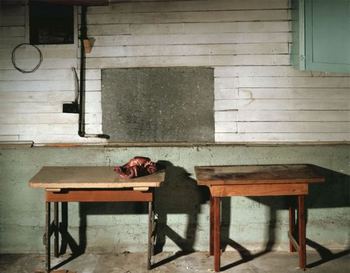 In a spare and bleak room, it's an untidy knot of formerly organic matter grown dried and leathery, like a baseball glove forgotten in the back of a closet. It evokes the disarray of abandonment, not to the thrill of a species-to-species encounter.
In a spare and bleak room, it's an untidy knot of formerly organic matter grown dried and leathery, like a baseball glove forgotten in the back of a closet. It evokes the disarray of abandonment, not to the thrill of a species-to-species encounter.In the Western world, octopi live in fantasy as monsters. In the East, they are monsters on a mission. (Hokusai; not safe for work.)
Masami Teraoka (also not safe for work) added condoms. His are comic emblems of the orgasmic. Woody Allen once said that sex was the most fun he ever had without laughing. Teraoka's fetishists of the sea bring these pleasurable opposites together.
Daikichi Amano - If a little is good, more is better.
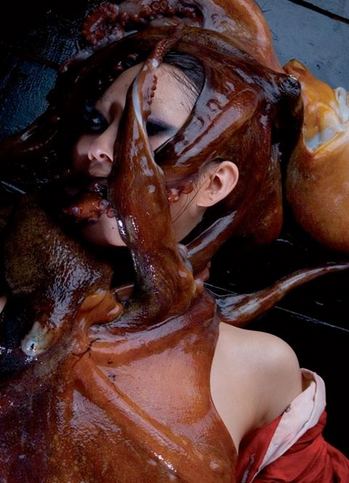 Also hitting that Japanese fish & sex note is Hajime Sorayama.
Also hitting that Japanese fish & sex note is Hajime Sorayama.Lastly, for the carny touch: Germs4u.
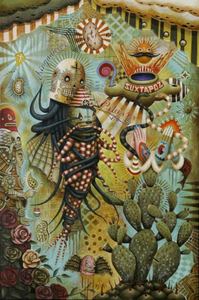
On the road to the Nome King in Frank Baum's Ozma of Oz, an obscure sequel to the Wizard of Oz, Dorothy happens upon a Hammering Man.
The iron giant is a fine fellow,' said Tiktok, 'and works as steadily as a clock. He was made for the Nome King by Smith & Tinker, who made me, and his duty is to keep folks from finding the underground palace. Is he not a great work of art?'
Jonathan Borosky's working stiff continues to hammer, which can't be said of those it so ambiguously represents. Besides the one in front of the Seattle Art Museum, which at 48 feet is the largest in the series after one in Frankurt, Borosky's men - nearly a dozen strong - pound out silent and unchanging beats in NYC, Minneapolis, Los Angeles, Basel, Seoul, and Washington, D.C.
In Seattle at least, the big man is hit. Against the backdrop of Robert Venturi's facade, which was partially inspired by Chinese restaurants, it holds its place: Venturi's complex elegance vrs. Borosky's droning mechanics.
Even so, I prefer its colorful kin. They're short, but they know how party and wouldn't consider pounding away at nothing for the duration of their unnatural lives.
(Image via. Click to enlarge.)
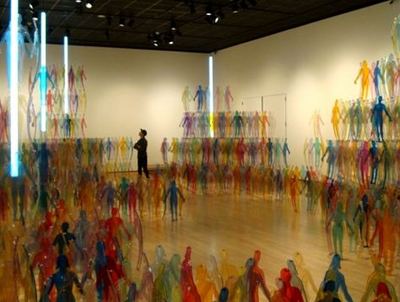
The National Gallery, the Met, the Huntington and the Nelson-Atkins have all opened major American presentations this spring. (The Met isn't done: Its American paintings and sculpture galleries open in 2011.)
Opening next year in Arkansas, Crystal Bridges (collections link here) is sure to transform the field.
In the meantime, Green wondered the following:
On a morning when an American president born in Hawaii to a Muslim Kenyan father and a Kansasan mother is speaking about Islam, Israel and the United States at Egypt's Cairo University, while back home a Latina visits Capitol Hill to drum up support for her landmark nomination to the Supreme Court and while New Hampshire becomes the sixth state to offer state-level marriage equality, does it make sense for our art museums to present American art galleries that present American art as it might have been considered in 1935?Really, 1935? There wasn't a great deal of enthusiasm for historical American in 1935. Let me first say I'm happy to have a dog in this race. When the Seattle Art Museum reopened in 2007, it was (for the first time) with an American wing. What is old hat in this material on the East Coast is less so in the West and especially in the Northwest, where its absence has been nearly total.
The problems in building these collections are dramatic. American historical art is now a big crowd pleaser. With the best material increasingly hard to come by, it's tempting to offer second tier work from stars rather than shake up the field with first-rate work from lesser knowns.
Because it apparently went for the former, Christopher Knight found the Huntington lacking, here. So did a well-informed blogger going by the name of Los Angeles County Museum On Fire, here. (Who? Who knows? On the Web, nobody knows if you're a curator at one of the institutions you deplore. Or not.)
(For this topic, we need Robert Hughes back at his peak. Failing that, we can reread American Visions.)
SAM shines in the quality of what it has collected. Starting late, it came on strong with the best material.
 Whiting Tennis offered something similar a couple of years ago titled Bovine.
Whiting Tennis offered something similar a couple of years ago titled Bovine.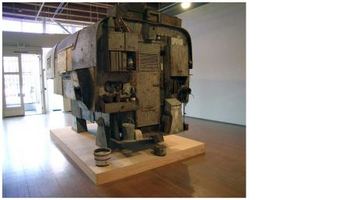 Some hard-scrabble hermit might have built either one from scraps and lived in it for decades, picking his nose and peeing out the door. Good luck to the guy. (I might be joining him shortly.) As art, however, both sculptures reek of frontier nostalgia and trade in wild West stereotypes. They're shabby chic without the chic.
Some hard-scrabble hermit might have built either one from scraps and lived in it for decades, picking his nose and peeing out the door. Good luck to the guy. (I might be joining him shortly.) As art, however, both sculptures reek of frontier nostalgia and trade in wild West stereotypes. They're shabby chic without the chic.Michael Darling bought Bovine for the Seattle Art Museum, where it is now, presumably, in pieces in a bin. (Make that a big bin.) If only Darling had waited. (Tennis' for-the-ages piece here.)
The big daddy of this sensibility is Ed Kienholtz. Hayes-Chute's and Tennis' sculptures are mites, and Kienholtz's are mountains.
Everybody recycles, especially now, when the idea of breaking new ground has itself broken down. Evoking the past is not the problem. It's evoking it in a half-assed, me-too manner, hoping to hitch a dull wagon to somebody else's bright star.
In an exhibit titled Second Peoples at the lamentably demised Tacoma gallery known as The Helm, the killer-good artist statement on the subject reads as follows:
We have coined the name 'second peoples' to describe the people who arrive late on the scene, after the beginning, after the abundance, after the traumatic event, after everything's been said and done, after, even, the end.
We are the second peoples. Chances are, you are too. This is an exhibition dealing with what it means to be second. We inhabit a landscape of iteration, reverb, elision, and generational noise. Our corner of North America - these mountains, that timber, this rich land - belonged to someone else. Our popular culture-those TV shows, that movie sequel, this new band that is so retro they're cool-belonged to some other time. Our art is that way, too: this gesture to Donald Judd, that nod to Philip Guston, that Eva Hesse wink.
We are interested in locating the coordinates of this second position. How did we end up here? What is our responsibility for what happened before us? What is our responsibility for the things that happen now in our names? Like Simone de Beauvoir argues in "Second Sex", we think we should be free to transcend ourselves as subjects, to not be confined to existential leftovers.
Contemporary art is concerned with this alchemy, trying to turn second-handedness into first-handedness, reversing the flow of energy, presenting not representing, creating value from valuelessness. We think this is a worthwhile activity. We also think it is a fraught activity. The work in this exhibition exposes some of the fractures created by this ceaseless turning, and also dreams of a third position, a reification of our desire to escape, a momentary place to stop.For a brilliant, 21st-century version of the Kienholtz aesthetic, go here for a look at a Seattle Art Museum project by the brothers Oscar Tuazon and Eli Hansen. (It's another Michael Darling effort. He is who is in Seattle curatorial circles. In his field, nobody else comes near.)
Artists who insist on posting only current work on their Web sites miss the opportunity for their work to be considered across their careers. Some spit on that opportunity. They want their old work to disappear from this earth. It's the new them that interests them. Requests for images from critics who want to look backward will be ignored.
Ignored is not the worst option. Was it something I said? After I noted on this blog that Holderfield's Web site would not release images into the image stream, Holderfield shut it down entirely. I hope it was a coincidence. At least reproductions of old work could be seen. Now there's only the small version of what's current at the artist's gallery.
Holderfield's rugs and chairs slimed their way out existence with a magnificent stink, which can't be said for Allison Kudla's experiments in a similar vein.
Her delicate wallpaper continues to evolve, as do her tiles.
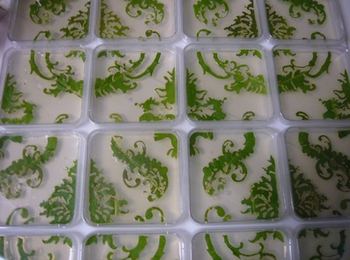 Kudla recently got a Gap Grant from Artist Trust. For a list with links to recipients' work, go here.
Kudla recently got a Gap Grant from Artist Trust. For a list with links to recipients' work, go here.While on the subject of dangerous waste, James L. Acord deserves a mention.
(Below, portrait of the artist in his hasmat suit, via.)
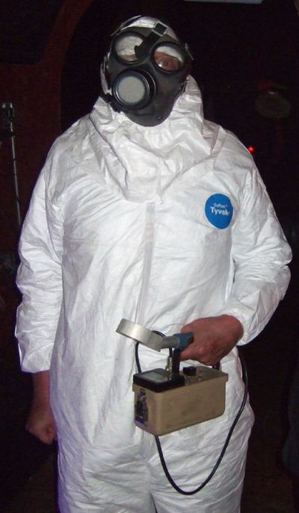 Prominent in Seattle in the 1980s, Acord moved to Richland early in the 1990s to hob-nob with engineers on the Hanford Nuclear Reservation. His aim was to make sculpture from nuclear material, more specifically, to transmute a radioactive isotope of technetium to a stable or
nonradioactive isotope of ruthenium and incorporate it into a stone and
advanced metal alloy sculpture.
Prominent in Seattle in the 1980s, Acord moved to Richland early in the 1990s to hob-nob with engineers on the Hanford Nuclear Reservation. His aim was to make sculpture from nuclear material, more specifically, to transmute a radioactive isotope of technetium to a stable or
nonradioactive isotope of ruthenium and incorporate it into a stone and
advanced metal alloy sculpture.Determined to shed his old identity and become somebody with whom engineers might identify, he frequented Richland's Goodwill store, buying the kind of suits, ties and shirts engineers wear. His hair he cropped down to a military crew cut. His shirt pocket sprouted a pen protector. As he said at the time:
The less you frighten people, the further you get. People here tend to think of artists as the enemy. Conversation bump along on square wheels, but they bump along.
If artists are the enemy, they're not the kind of enemy Richland residents need to worry about. In his time there, Acord found few others. When he was featured in a two-part profile by Philip Schuyler in The New Yorker (October '91), he was unable to find the magazine on sale in the Tri-Cities area. (Acord's project covered in the Guardian here.)
In 1993, after endless negotiations with the Department of Energy, Acord became the only individual on the planet licensed to ``own and possess" nuclear material. To mark his triumph, he had the license number tattooed on the back of his neck, regrettably undercutting his efforts to pass for a local.
Alchemy is the age-old dream. I want to render high-level nuclear waste harmless and use it in sculpture.
If nuclear waste can be rendered inert, why isn't it done? Expense is the reason the Department of Energy gives, but Accord had other ideas.
The Department of Energy is like the Catholic Church in the 12th century. It's a fully mature bureaucracy. It's committed to the dogma that waste should be buried in the ground. It has 30 years of studies worth billions of dollars saying that waste burial is good. Getting it to backtrack is hard.(Anyone with current info on Acord, please post in the comments.)
Taryn Simon, photo and text, from her American Index of the Hidden and Unfamiliar: contaminated ground in watery blue light. Always nice to see how the Evergreen State strikes artists from elsewhere. (Bio from Gagosian.)

Nuclear Waste Encapsulation and Storage Facility Cherenkov Radiation Hanford Site, U.S. Department of Energy Southeastern Washington State.
Submerged in a pool of water at Hanford Site are 1,936 stainless-steel nuclear-waste capsules containing cesium and strontium. Combined, they contain over 120 million curies of radioactivity. It is estimated to be the most curies under one roof in the United States. The blue glow is created by the Cherenkov Effect which describes the electromagnetic radiation emitted when a charged particle, giving off energy, moves faster than light through a transparent medium. The temperatures of the capsules are as high as 330 degrees Fahrenheit. The pool of water serves as a shield against radiation; a human standing one foot from an unshielded capsule would receive a lethal dose of radiation in less than 10 seconds. Hanford is among the most contaminated sites in the United States.
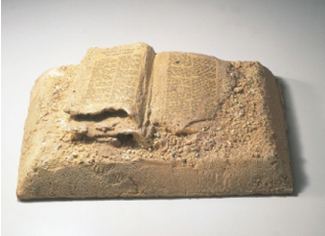 (Another version)
(Another version)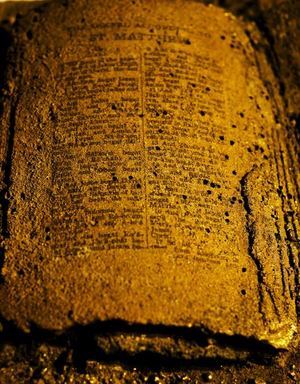
Emily Pothast, The Holy Bible:New American Revision (By crossing out everything that did not pertain, she found a text within the text devoted to violence and cruelty.)
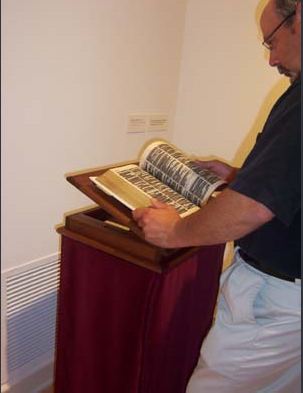 Detail: (Click to enlarge:)
Detail: (Click to enlarge:)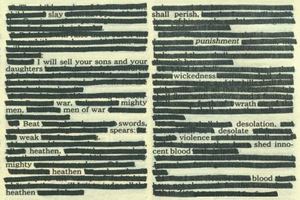 I like what Elie Wiesel told a man who boasted of keeping a Jewish friend's Torah safe in Berlin during the war. Learning that the friend did not survive, Wiesel told the man he should have kept the Jew safe and let the Nazis have the Torah. There are always more where that Torah came from, but in the Jewish tradition, if you save a life, you save the world. In the Roman Catholic tradition, the blood of the martyrs is the seed of the Church. It's true: Jews are more sensible than Catholics.
I like what Elie Wiesel told a man who boasted of keeping a Jewish friend's Torah safe in Berlin during the war. Learning that the friend did not survive, Wiesel told the man he should have kept the Jew safe and let the Nazis have the Torah. There are always more where that Torah came from, but in the Jewish tradition, if you save a life, you save the world. In the Roman Catholic tradition, the blood of the martyrs is the seed of the Church. It's true: Jews are more sensible than Catholics.The opportunity to see in Seattle a sample of his early work is invaluable. (Click images to enlarge.)
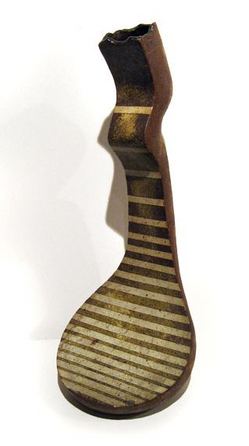
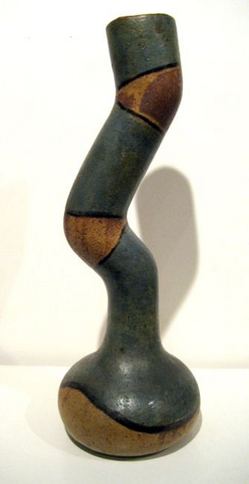
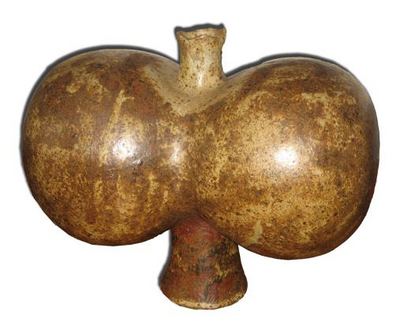
The unexamined life may not be worth living, but it's easier on the digestive tract.
Art critics say they make aesthetic judgments about art, not about whatever political content might serve as its subject matter. This stance is easy for the typically leftist critic, because virtually all art with overt political content comes from the left. It's against the usual negatives (war, racism, sexism, concentrated wealth, wasteful carbon footprints) and in favor of the usual affirmatives (civil rights, human rights, economic justice, social diversity and so forth.)
Happily I proceed, unchallenged, until considering the work of Charles Krafft. (Or, recently, nostalgic/romantic art about Boy Scouts.) In both cases, I find that I am not as open-minded as I think I am; that when it comes to political content, I am not open-minded at all.
Krafft is having an accidental career survey at a resale gallery known as Seattle ARTresource, with a dozen paintings from the 1980s onward and 18 hand-painted ceramic plates from his Disasterware series.
Seeing a fair sample of Krafft's plates together for the first time in years, I was struck by their secret narrative. They are an extended version of the artist's self-portrait, featuring the prickly ground of his compulsion to offend.
To a Nazi-loving skinhead who told the artist he was his hero, Krafft replied,
I can't imagine why. I'm making fun of you people.
More accurately, Krafft is making fun of everybody, including himself.
In 1992, when he had his last exhibit in a mainstream Seattle gallery (Davidson), Sam Davidson told me he was troubled by his own insistence that one of Krafft's Disasterware plates not be in the show. After taking a look at the censored plate, I said, "Good call."
I've been asked to read a couple of letters to the editor about arts coverage. Arts coverage? Let's not bring up arts coverage. In the new PI, there isn't any.Two-and-a-half months have elapsed since the Seattle Post-Intelligencer ceased print publication. Its passing has been commemorated through private parties, radio shows, documentary films and countless news stories. (Photo via.)This Wednesday night, the community gets its chance to say farewell. Journalism organizations from around the region are co-sponsoring a free public tribute to the newspaper and its contributions to Seattle. The program will include a multimedia retrospective of the newspaper's 146 years of publication, a musical performance by Heidi Muller and appearances by special guests including historian John Hughes and author Bruce Barcott. P-I favorites such as David Horsey, Art Thiel and Regina Hackett are scheduled to appear. Ken Schram will emcee. The event will be from 6:30 to 8 p.m. Wednesday, June 3, at Town Hall. Admission is free but reservations are required. Call 206-331-1276 or e-mail seattlepitribute@gmail.com.
On view through Wednesday is Dimensional Invention curated by KAC gallery director (and artist) Cable Griffith.
Claire Cowie: Her pastels are shades not found in nature. Her mutant rodents grow like vegetables in webbed ground, content to be what they are, isolated pause points in .a mass of connection.
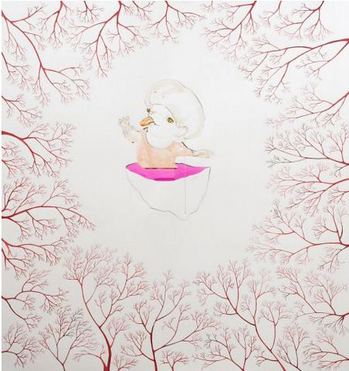
Patrick Holderfield heats minimalism to the point of implosion in order to turn time against itself.
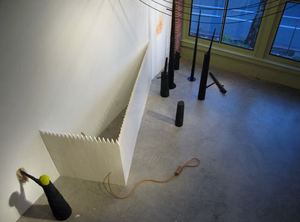
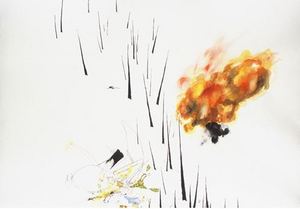
Whiting Tennis slouches toward Bethlehem to be born.
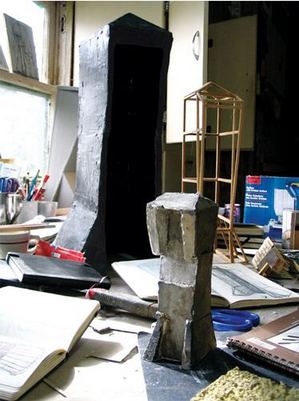
Painter Tim Cross finds in three dimensions a mirror through which he sees darkly.
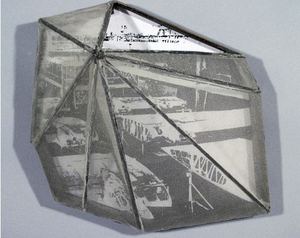 Ben Hirschkoff: His clouds explore the tragedy of the costume jewelry - all of the aspirations but none of the verisimilitude.
Ben Hirschkoff: His clouds explore the tragedy of the costume jewelry - all of the aspirations but none of the verisimilitude.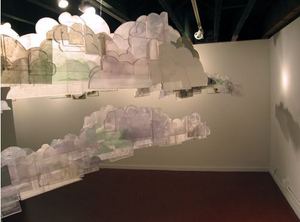 Patricia Hagen creates the material equivalent of ripe organics in their dying fall, leaking their lives away.
Patricia Hagen creates the material equivalent of ripe organics in their dying fall, leaking their lives away.1. Lopez Island wood carver Michael Peterson begins with chunks of green fir, hemlock, cedar or madrone. He needs it to be wet, almost pulpy, so he can hollow it out with a chainsaw and shape the edges. As the piece dries, it shrinks and pulls, extending the marks of the chain into long gullies that the artist smooths by sandblasting and sometimes bleaching.
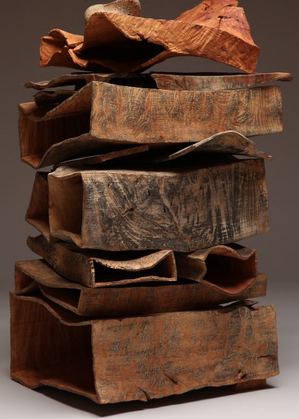 The natural world is putty in his hands, and the force he brings to bear is a kind of erosion. When he presents them in layers, each is free, with nothing rooted or glued down.
The natural world is putty in his hands, and the force he brings to bear is a kind of erosion. When he presents them in layers, each is free, with nothing rooted or glued down. To September 20. Peterson is represented by the Traver Gallery.
2. Portland's Judy Hill is an artist who dares to repeat herself. For decades she has fashioned the same figures in colored glass and raku, which is not, in contemporary art, thought to be a good thing. For her, it is.
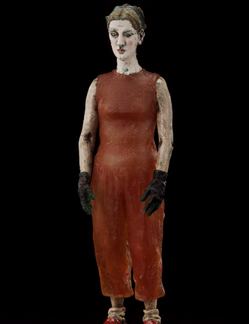 The glass looks like previously-licked lollipops, overheated and on the verge of melting. The clay is corrosive, grizzled and seamed. Her women have been through a lot, but their
The glass looks like previously-licked lollipops, overheated and on the verge of melting. The clay is corrosive, grizzled and seamed. Her women have been through a lot, but their confectionery, free-floating attire makes it impossible to sum them up or write them off.
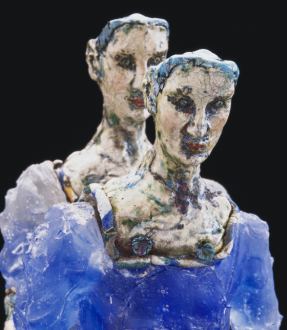 Through January 3.
Through January 3.3.The Book Borrowers: Contemporary Artists Transforming the Book : Using the Edward Ruscha rule, if Michael Peterson's work is huh? wow!, then the artists in this show tend toward wow! huh.
Peter Schjeldahl explains:
Start anywhere. Look. Wonder why any given art is the way it is and not some other way. The artist made certain choices, producing certain effects. Walk back the cat, as they say in espionage. Perhaps read art historians and critics for clues--but not solutions. Your own pleasure must be your goal and guide. A great deal of art, of any period, is ridiculous. But you won't be a fair judge unless you consent to regard each work as sincere and intelligent until proven otherwise. (Developing taste speeds up the process, but it's still a process.) If you hate a work on first sight, fine. That's an authentic response. But stick around. Keep looking. You will have further responses. You might end up hating the work even more, but with an enriched understanding of both it and yourself. Very often, our judgment evolves the other way: what we think we like, at first, disappoints upon contemplation. The artist Edward Ruscha promulgated a handy rule in this regard: "Bad art is 'Wow! Huh?' Good art is 'Huh? Wow!'About the Book Borrowers, I wouldn't go so far as to say bad. No rule, no matter how catchy, works outside its own inevitability narrow framework. But thanks to their material invention, these artists have an immediate appeal, although there's little in the way of a second punch.
That said, I'm extremely fond of Long-Bin Chen's Guan Ying with Flower Crown (Ming Dynasty), 2007, carved from Manhattan white pages phone books. I do not believe that custom would stale its variety. Years from now, if I happen upon it, I'll say, "From phone books. Wow."
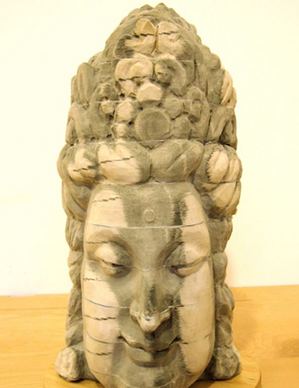 To June 14.
To June 14. In 2005, when it reopened as a crafts center, BAM hosted Garth Clark's traveling show, The Artful Teapot, featuring the best in contemporary pots. After that came a long, slow slide.
A craft museum has to take up its bed and walk. It has to assume the burden of its niche, honor its legacy and cut a new path through the thicket of material creation. Objects wandering between worlds, too proud to be craft and too timid to be art, are not going to cut it.
By 2008, BAM had righted itself, although its difficult galleries were awkward hosts for the exhibits they housed. Good artists ended up looking at if they were waiting for their space to materialize and had unpacked their work in the hallway as a temporary measure.
Now, halfway through 2009, everything clicks: the art, the space, the flow, the light and the installations.
BAM is the ultimate come-from-behind institution. It's surely the only art museum to have announced its own death, shut down and revived its own corpse a year later, in BAM's case, with a craft-driven mission.
Like virtually every other culture institution in the country, money's tight, but unlike so many others, attendance is a bright spot. According to Tanja Baumann, director of marketing, BAM's first quarter numbers reveal a solid advance, from 6,338 in 2008 to 9,496 in 2009.
Next post, a review of the
Click images to enlarge.

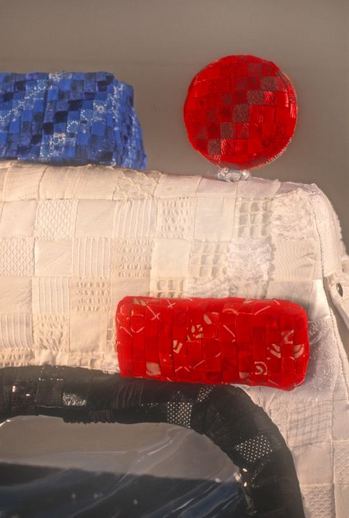
 Lawrence Ferlinghetti's salute to the species here. Below, the ending, because I quoted from it in the headline.
Lawrence Ferlinghetti's salute to the species here. Below, the ending, because I quoted from it in the headline. The dog trots freely in the street
and has his own dog's life to live
and to think about
and to reflect upon
touching and tasting and testing everything
investigating everything
without benefit of perjury
a real realist
with a real tale to tell
and a real tail to tell it with
a real live
barking
democratic dog
engaged in real
free enterprise
with something to say
about ontology
something to say
about reality
and how to see it
and how to hear it
with his head cocked sideways
at streetcorners
as if he is just about to have
his picture taken
for Victor Records
listening for
His Master's Voice
and looking
like a living questionmark
into the
great gramophone
of puzzling existence
with its wondrous hollow horn
which always seems
just about to spout forth
some Victorious answer
to everything.
Via.


Besides the emblem of a conversion of a nation by means of flowers and a painting, the image is a viewer finder. Look in her eyes to see Juan Diego, her first convert, gazing at red flowers falling from her blue cloak.
The painting that was once housed here, a lovely church that continues to sink into the ground, hangs in the architectural monstrosity below. The sight of this Star Wars' spaceship does not deter those who crawl on bloodied knees across a wide plaza to enter it.
 Inside for the first time, anyone hoping to get a good look at what passes for the only artwork painted by God is disappointed. The church is cavernous, the painting small. Even in the front pews, it's far away.
Inside for the first time, anyone hoping to get a good look at what passes for the only artwork painted by God is disappointed. The church is cavernous, the painting small. Even in the front pews, it's far away.Fear not. Between the altar and the painting are two moving sidewalks. Ushers separate the crowds into opposing streams, both of which can peer up for a fast, pseudo-intimate look.The day I was there, in the late 1980s, I was awed by what appeared to be the sorting mechanism: Tourists on one side, faithful on the other.
How did the ushers know? The devout were not limited to locals or those clutching rosary beads, nor were the secular entirely tourist-like. Invited (forced) into the tourist stream, I've been wondering about it since. It's my personal mystery of Guadalupe, a scan for belief that found me lacking.
Friends who were with me that day say I imagined the whole thing, that the differences between the two groups were accidental and of-the-moment. They're wrong. Wherever they look, they see the secular and nothing else. They don't wander between worlds, attracted to both and not quite at home in either.
Back to the part that cannot be disputed, the moving sidewalk. Usually, art stands still, and people pass it by. Like the moving sidewalks of the Guadalupe church, Tony Oursler intensified the equation, but for different reasons.
His talking heads gather to gripe behind a hole ripped into the wall in the middle of an escalator in the Seattle Central Library. As media-savvy descendants of Humpty Dumpty, they're high-tech oddballs.
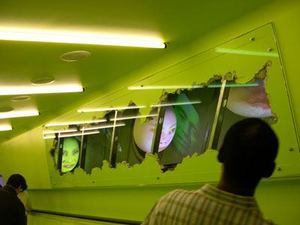 Learning from fallen egg's tragedy, they avoid his fate by remaining stationary, not that they have a choice.
Heads are all they are -- video projections on ovals. As library patrons pass them by, the heads maintain a running commentary on their condition. They mutter darkly, roll their eyes, purse their lips and wrap their impersonations of the lunatic fringe in comic resilience.
Learning from fallen egg's tragedy, they avoid his fate by remaining stationary, not that they have a choice.
Heads are all they are -- video projections on ovals. As library patrons pass them by, the heads maintain a running commentary on their condition. They mutter darkly, roll their eyes, purse their lips and wrap their impersonations of the lunatic fringe in comic resilience.
According to numerous reports, museum visitors typically spend between 1.5 and 5 seconds looking at individual artwork, when they bother to stop at all. The beauty of Oursler's piece is that it plays with that forlorn piece of data. Because they're in motion, passers-by can't linger. Being forced to see quickly could stimulate the desire to see more. Children aren't the only ones riding the loop up and down and back again to take another look at Oursler's outcasts.
The moving sidewalk of Guadalupe? I haven't been back, but Oursler's figures regularly call my name. Sometimes I stop at the library just to see them, desire frustrated by the built-in limitation of the opportunity.
Before I scored a job at the PI, I was turning into one of them, lugging unpublishable manuscripts in a satchel into the library and muttering to myself about obscure points of art history. Plus, there's another reason to visit: Only by going to the library can this particular Oursler be seen, but Guadalupe's lovely lady is everywhere. She has, like Yeats, become her admirers.
Young artists aren't hot to attend museums? (Some of the young, some of the museums.)
At least they don't want to burn them down. Oft-told tale told again in the New York Times:
After other leads fizzled, attention turned to Picasso and Apollinaire and their gang of young, avant-garde poets and artists. This group, sometimes called la bande de Picasso, was famous for its seething dislike of the kind of stale museum art that the Louvre represented. Apollinaire had signed a manifesto that threatened to "burn down the Louvre."
In museums throughout America's circa-1965 industrial heartland, Gilliams hang next to Frankenthalers hang next to Nolands. They all look a bit dated, like an end rather than a beginning.This from an art blogger who celebrates the Western kitsch of Frederick Remington. The fault, dear blogger, lies not in our stars that we are underlings.
Gilliam:
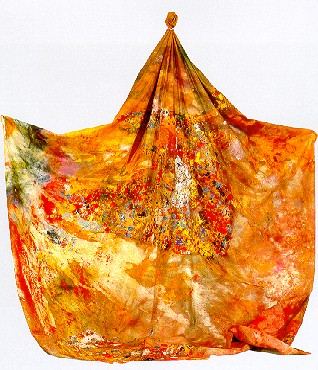 Frankenthaler:
Frankenthaler: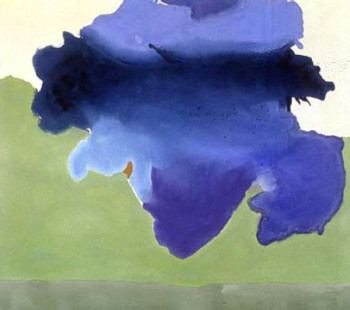 Noland:
Noland: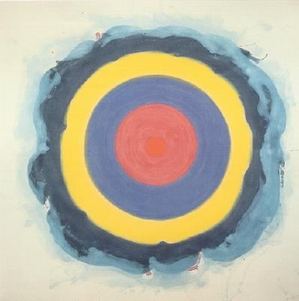
Dobrznyski:
This entry is about art students who won't go to art museums. Apparently, some students today think that viewing art online is good enough or better. That's what I discovered reading a blog item by Laurie Fendrich, a painter who lives and works in New York and is a professor of fine arts at Hofstra University.Dobrznski didn't link to the Fendrich story; here it is. (Fendrich doesn't appear to link to her sources either.)
Fendrich:
Yesterday a colleague who teaches painting emailed me that it's hard for him to get his students to go to a museum to look at a work of art. They just can't see the point. Why schlep into New York to go to a museum to see a painting, especially since, as often as not, the hyper-bright, clean crisp image of it that's posted on the museum's Web site makes the real thing look limp and lame by comparison?They're both missing a salient point understood by the students. A lot of art today is about the replication of imagery. Its aura, in the Walter Benjamin sense, is not lost in mechanical reproduction. It exists because of mechanical reproduction.
Michael Kimmelman learned this when he asked Cindy Sherman to visit the Met with him in 1996, as part of a NYT portrait series he turned into a book. She told him she rarely went to the Met. She was in fact surprised that paintings have a different kind of life in person than they do in catalogs, where she's used to seeing them. She claimed not to have previously noticed this elementary (Watson) fact. She didn't notice because she doesn't need it. That's not what her work is about.
Sherman To Kimmelman on the history of her medium (art historians, avert your eyes):
I'm illiterate in the historical, classic knowledge of photography, the stuff teachers attempted to bore into my head, which I resisted. The way I've always tried to cull information from older art and put it into my work is that I view it all anonymously, on a visceral level. Lately I've been looking at a lot of images from Surrealism and Dada, but I never remember which ones are the Man Rays, say, because I'm just looking for what interests me.Some artists don't go to museums until their own work is there, and some, like Sherman, tend not to go even then. This is neither shocking nor cause for hand-wringing.
Bruce Barcott on a disgraceful name enshrined in honor at the Seattle Art Museum, in City Arts Seattle:
My daughter and I were strolling through the Seattle Art Museum recently, enjoying the treasures in the museum's still-feels-new expansion wing, when I turned a corner and saw these words: "Kerry & Linda Killinger Gallery."
I stood there, gobsmacked.
The Killinger Gallery: I'd never noticed it before. Donor names on gallery walls and theatre seats are so ubiquitous that they rarely register. But this one popped up as if lit up in Dan Flavin neon. Here was Seattle's culpability in the global economic crisis laid bare. Here was our shame displayed.
Susan Robb: Her Warmth, Giant Black Toobs is in Houston. The able Douglas Britt has the story, here.
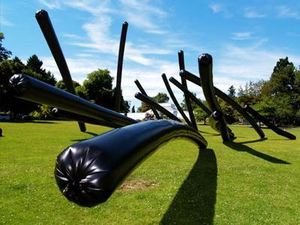 From Blade Diary via Eyeteeth: What to do with abandoned newspaper boxes:
From Blade Diary via Eyeteeth: What to do with abandoned newspaper boxes: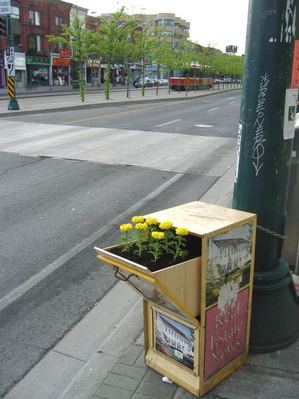 Finally, Ellsworth Kelly (the dress) from Greg.org and Ellsworth Kelly (the interview) from Kenneth Baker. Ellsworth Kelly now, Ellsworth Kelly forever.
Finally, Ellsworth Kelly (the dress) from Greg.org and Ellsworth Kelly (the interview) from Kenneth Baker. Ellsworth Kelly now, Ellsworth Kelly forever.EJ Hauser:
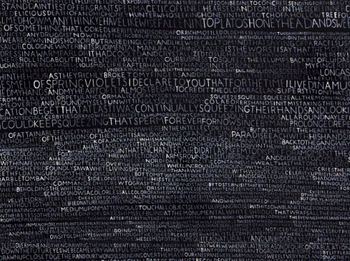 Ben Beres (detail):
Ben Beres (detail):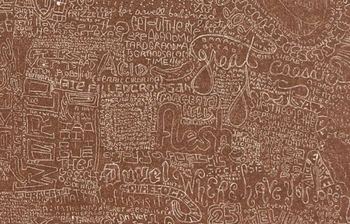 Also, why stay afloat? The allures of going under, below.
Also, why stay afloat? The allures of going under, below.Sarah Sze:
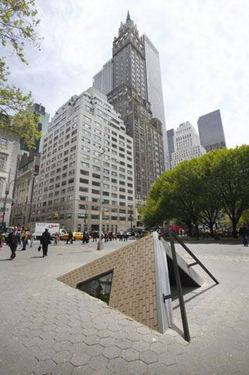 SuttonBeresCuller:
SuttonBeresCuller:
About
Blogroll
AJ Blogs
AJBlogCentral | rssculture
Terry Teachout on the arts in New York City
Andrew Taylor on the business of arts & culture
rock culture approximately
Laura Collins-Hughes on arts, culture and coverage
Richard Kessler on arts education
Douglas McLennan's blog
Dalouge Smith advocates for the Arts
Art from the American Outback
Chloe Veltman on how culture will save the world
For immediate release: the arts are marketable
No genre is the new genre
David Jays on theatre and dance
Paul Levy measures the Angles
Judith H. Dobrzynski on Culture
John Rockwell on the arts
innovations and impediments in not-for-profit arts
Jan Herman - arts, media & culture with 'tude
dance
Apollinaire Scherr talks about dance
Tobi Tobias on dance et al...
jazz
Howard Mandel's freelance Urban Improvisation
Focus on New Orleans. Jazz and Other Sounds
Doug Ramsey on Jazz and other matters...
media
Jeff Weinstein's Cultural Mixology
Martha Bayles on Film...
classical music
Fresh ideas on building arts communities
Greg Sandow performs a book-in-progress
Harvey Sachs on music, and various digressions
Bruce Brubaker on all things Piano
Kyle Gann on music after the fact
Greg Sandow on the future of Classical Music
Norman Lebrecht on Shifting Sound Worlds
Joe Horowitz on music
publishing
Jerome Weeks on Books
Scott McLemee on books, ideas & trash-culture ephemera
theatre
Wendy Rosenfield: covering drama, onstage and off
visual
Public Art, Public Space
Regina Hackett takes her Art To Go
John Perreault's art diary
Lee Rosenbaum's Cultural Commentary
